
Situated in the northern celestial hemisphere, the constellation Aries belongs to the renowned zodiacal circle, as it lies along the path of the Sun. Aries is flanked by the constellations of Pisces and Taurus, and it also has some neighboring star clusters that fall outside the zodiacal circle.
Aries holds the distinction of being the first constellation in the zodiac. Its name, derived from the ancient Greeks, means “ram” as the scholars, notably Cleostratus of Tenedos, believed that the constellation resembled the horns of a ram.
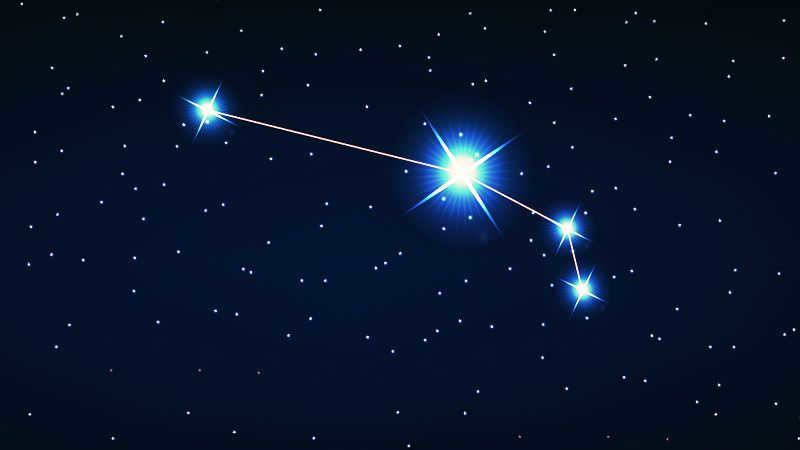

Aside from its role in the zodiac, Aries is renowned for its association with the ancient Greek myth of the Golden Fleece. Aries, depicted as a winged ram with golden wool, was sent by the goddess Nephela on a mission to rescue her children. The ram successfully completed its task, but was ultimately sacrificed to other deities. The Golden Fleece, the ram’s skin, was left in the gods’ temple, while the ram itself was immortalized as a constellation in the sky.
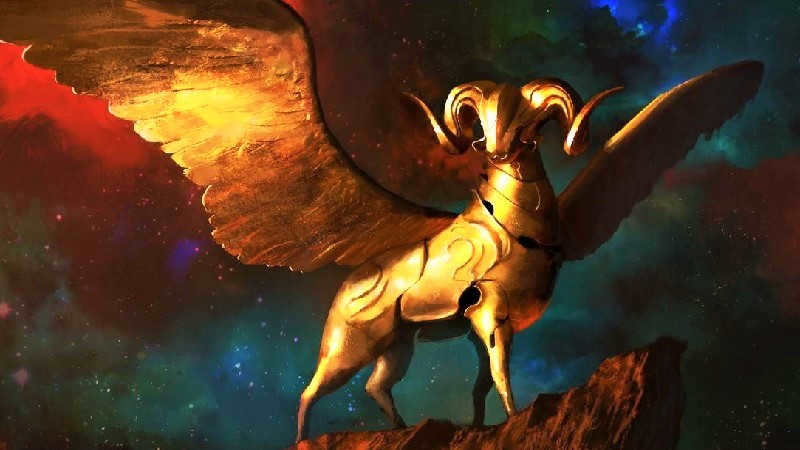
Constellation of Aries: Stars and Their Meanings
The primary and most prominent star in the constellation of Aries is known as Alpha, or Hamal. This star, an orange giant, gets its name from its resemblance to the head of a ram.
The second brightest star, Beta, is called Sheratan, which means “two signs” in reference to its historical association with the vernal equinox alongside Gamma Aries, also known as Mezartim.
In addition to these three stars, there are five others in the constellation of Aries, although they are not as noticeable and are often overlooked.
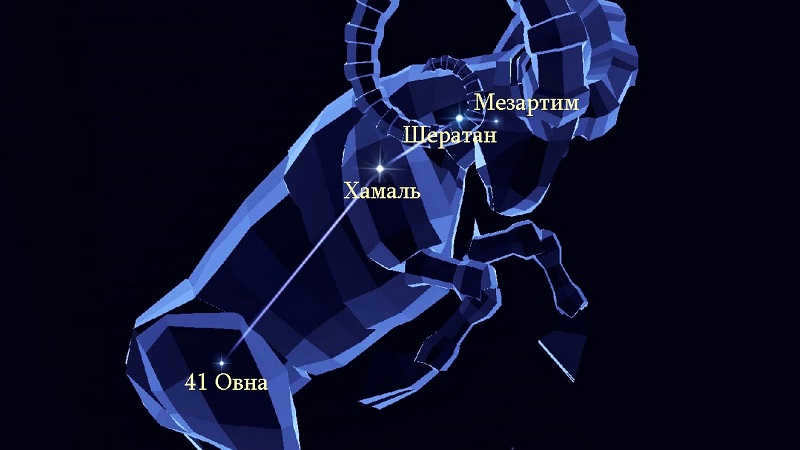
Constellation Aries
The Aries constellation encompasses an area of 441 square degrees and ranks 39th in terms of size among all other constellations. Within this constellation, there are three spiral galaxies, one of which has been observed to have two supernovae simultaneously. Additionally, the irregular dwarf galaxy NGC 1156 can be found here. The irregularity of NGC 1156 is attributed to its lack of a distinct shape.

Astrological Observation
Due to the shifting of constellations, the Aries constellation can be observed in the northern hemisphere at any given time, except for the period from April 19 to May 14 (during this time, the Sun passes through it). The observation should be conducted within a latitude range of +90 to -59 degrees.
Typically, the shapes of constellations in the sky do not resemble their namesakes. It requires a vivid imagination to perceive a man carrying a snake in the Serpentor constellation and a shepherd in the Volopassus constellation. Aries, one of the 13 zodiacal constellations, is no exception. So, the question often arises, how can one locate the Aries constellation in the sky? Let’s explore.
To locate something, the first step is to understand its appearance. So, let’s begin by gaining an understanding of how Aries appears in the celestial sky.
Aries does not have any particularly bright stars within its constellation. The primary star, Hamal (or Gamal), serves as a reference point with a magnitude of 2. This means that Hamal’s brightness is comparable to the stars found in the Big Dipper. Even in a city sky illuminated by streetlights, Hamal can be easily distinguished.
The second brightest star in Aries is Sheratan. It is located to the right of Hamal and has a luminosity of 2.6 m.
The remaining stars are significantly less bright and are often invisible from urban areas. To distinguish them, one must observe from a darker suburban or rural sky. In such a sky, on nights without a visible moon, the star to the left of Hamal can be observed as 41 Aries, with a magnitude of 3.6. A fainter star, Mezartim or gamma of Aries, is located to the right and slightly below Sheratan, forming a chain on the right side. The rest of the stars are so faint that they can only be spotted outside of urban areas and on nights without a visible moon!
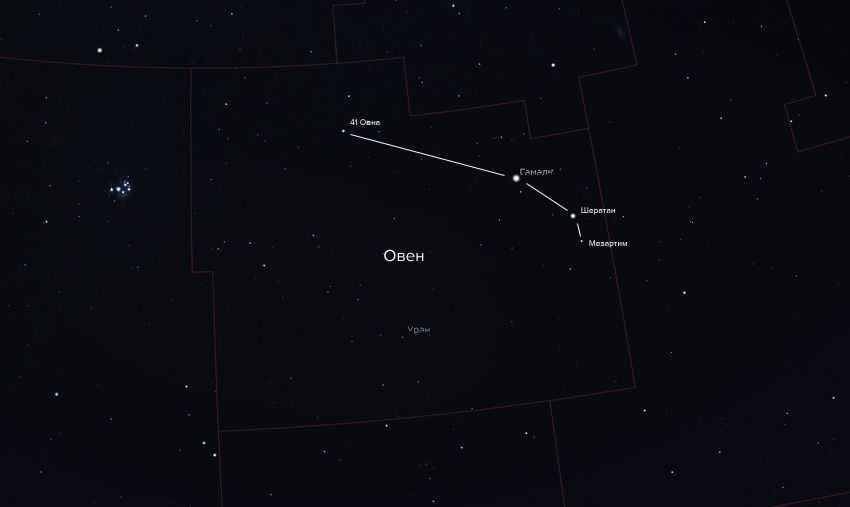
The constellation known as Aries can be observed in the night sky, with its boundaries outlined by red lines. It consists of a chain of stars that curves gracefully, with the two brightest stars positioned at its center. While it may not resemble the figure of a ram at first glance, one can use their imagination to connect the fainter stars and potentially see a resemblance to the animal. However, even on star maps, Aries appears much the same as described previously.
The star map displays the constellation of Aries, which consists of four prominent stars connected by a line. Additionally, there are numerous fainter stars located within the boundaries of the constellation. These stars can only be seen with the naked eye on moonless nights in a dark sky. This information is sourced from the International Astronomical Union (IAU).
When is the constellation Aries visible in the sky?
Although Aries is typically associated with the fall season, it can actually be observed for nearly 10 months of the year, from June to March. In June and July, Aries rises at dawn and appears low on the eastern horizon. In August, it rises in the late afternoon and can be seen in the east and throughout the night, eventually moving towards the southeast.
The optimal period for observing the constellation is between September and February. Throughout this timeframe, the constellation can be seen during the evenings and at night, positioned high above the horizon in the southern region of the sky.
During the month of March, Aries can be spotted in the western sky during the early evenings. During this time, the constellation gradually descends towards the sunset. Lastly, in April, the constellation becomes invisible due to the Sun being positioned within it.
Now that we have identified the appearance and visibility of the Aries constellation, let’s attempt to locate it in the nighttime sky. (When observing in urban areas, we search for the two most radiant stars, while in rural areas, we search for a sequence of four stars.)
An effective method for locating numerous constellations is to reference the position of the Big Dipper or Polaris. However, in this case, they will not be of use to us as they are located too far away from Aries in the sky. Therefore, we will rely on other reference points, specifically the neighboring constellations Pegasus and Andromeda. (These constellations are visible during the same time frame as Aries.)
How to locate Aries in relation to Pegasus and Andromeda
In the night sky, a prominent group of stars in Pegasus forms a large square known as The Square of Pegasus. To the left of this square, there is a curved chain of three stars that extends towards the east. This chain represents the constellation Andromeda. (If you continue to follow this chain, it will lead you to the star Mirfak in the constellation Perseus and the bright star Capella.)
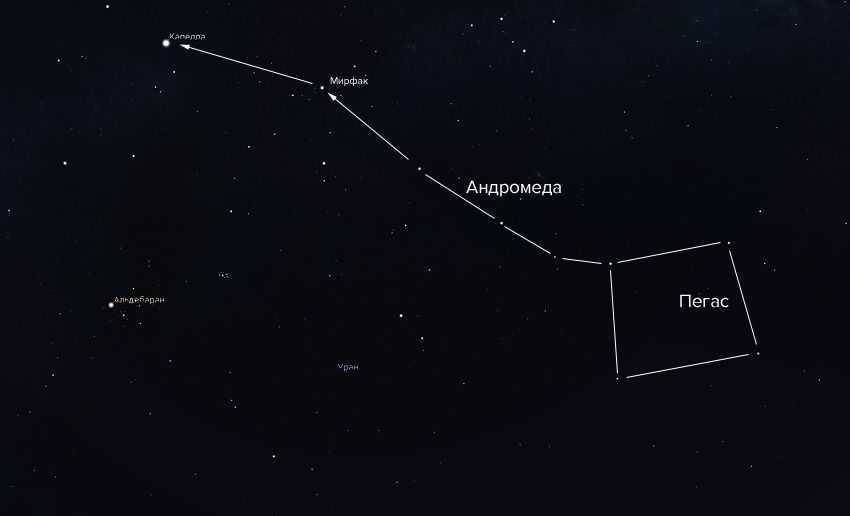
The configuration of Pegasus and Andromeda in unison creates a celestial shape resembling a colossal ladle or a pipe emitting smoke. Andromeda’s sequence of stars can be further extended towards the east to incorporate the radiant stars Mirfak and Capella. Configuration: Stellarium
When combined, the constellations Pegasus and Andromeda form a likeness akin to a ladle with a handle or an immense smoking pipe in the celestial sphere.
Thus, the constellation Aries lies to the left (east) of the Square of Pegasus below the Andromeda star chain.
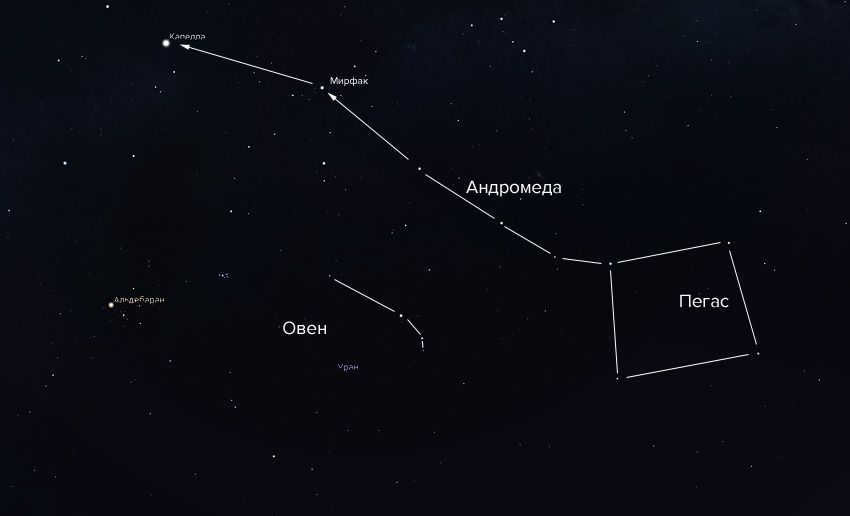
The Aries constellation can be observed below the chain of stars called Andromeda. Image: Stellarium
Please note that the stars Pegasus and Andromeda have a similar level of brightness to the two brightest stars in Aries, particularly Hamal.
The easiest time to locate the Aries constellation is during the autumn and winter seasons. During this time, it can be seen high in the sky in the evenings, maintaining its typical position: a slanted chain of stars towards the right horizon.
During sunrise, the Aries constellation appears parallel to the horizon. In this orientation, it can be observed during summer mornings and nights in August.
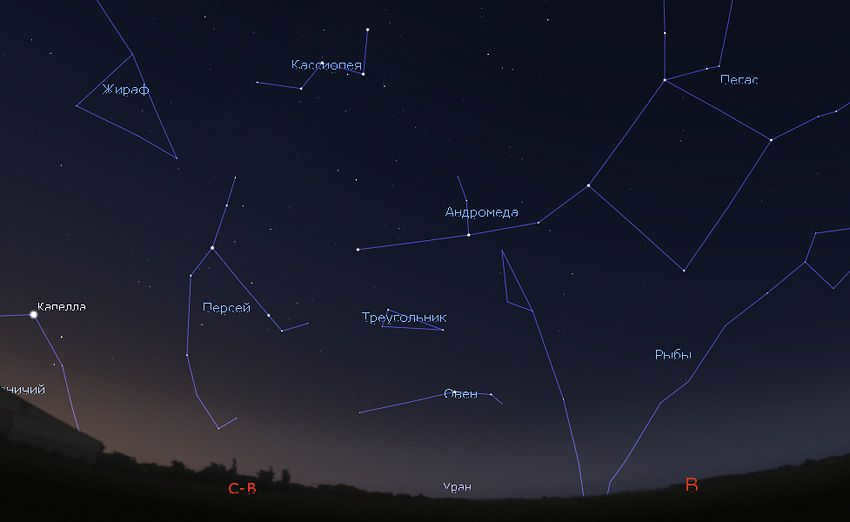
The Aries constellation can be observed in the sky during sunrise. Image credit: Stellarium
During the months of February and March, however, the Aries constellation tilts towards the west, aligning its stars vertically, thus pointing towards the horizon.
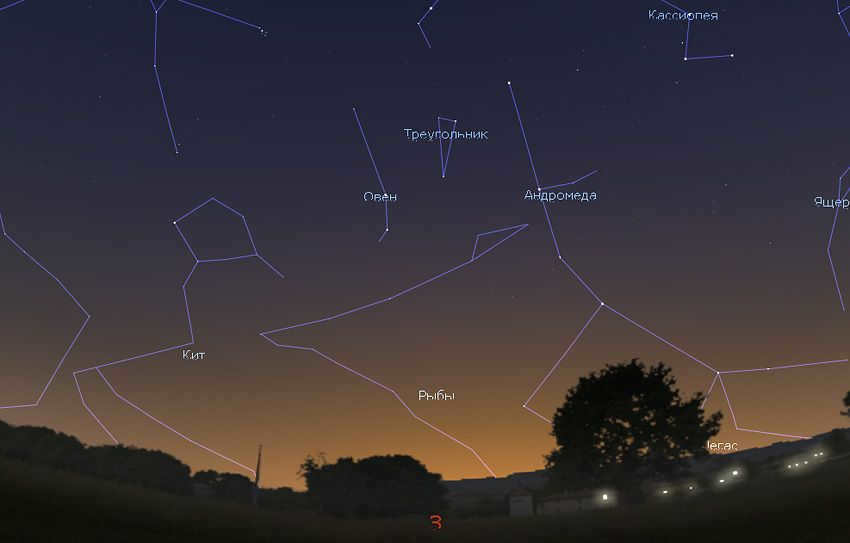
Witness the Aries constellation during sunset. This is its appearance during the late winter and early spring evenings. Image: Stellarium
However, the same phenomenon occurs with the primary landmarks when searching for Aries, the constellations Pegasus and Andromeda! The “Square with a handle” also aligns parallel to the horizon in the summer, slightly tilts in the autumn, and tilts strongly towards the horizon in late winter and March. By considering these factors, you will be capable of locating the Aries constellation in the sky at various times throughout the year and day.
However, it is important to note the following: Aries is a zodiacal constellation, which means that at times, the Moon and planets can be found within it. For instance, in the winter of 2021, Mars will be located in Aries, and in 2024, the planet Jupiter will also be in Aries. However, it is worth mentioning that while the Moon may obstruct the view of faint stars, the presence of bright planets can distort the pattern of the constellation, potentially leading to confusion.
March, the initial month of spring… There is no other month in which the length of the day increases as rapidly as it does in March! The winter constellations that have dominated the southern sky for almost three months begin to recede towards the west. They are then replaced by the constellations of spring. What does the starry sky look like in March 2020?
Well, it all depends on the time of observation. The actual constellations of spring replace the winter constellations closer to midnight. How faint and uninspiring they are! Can they even be compared to the brilliant constellations of Orion or Taurus? In the spring sky, there are only three stars of the first magnitude. They are named Regulus, Arcturus, and Spica. As for notable star formations, there is perhaps only one memorable pattern – the Trapezium of Leo.
However, the skies of March are only half spring skies. In the early evenings, the southern and southwestern part of the sky is occupied by Taurus and Ascendant, Orion and Gemini, the Big Dog and Little Dog. In short, the constellations of winter. And even farther to the west, following the sun, the fall constellations disappear below the horizon! Let’s begin our review with them.
Western horizon
Following the fading light of the evening, stargazers can observe the magnificent constellations of Pegasus, Andromeda, Pisces, and Whale gracing the western and northwestern regions of the celestial expanse. Hovering near the horizon in the west, one can spot the alluring constellations of Perseus, Aries, and Triangle.
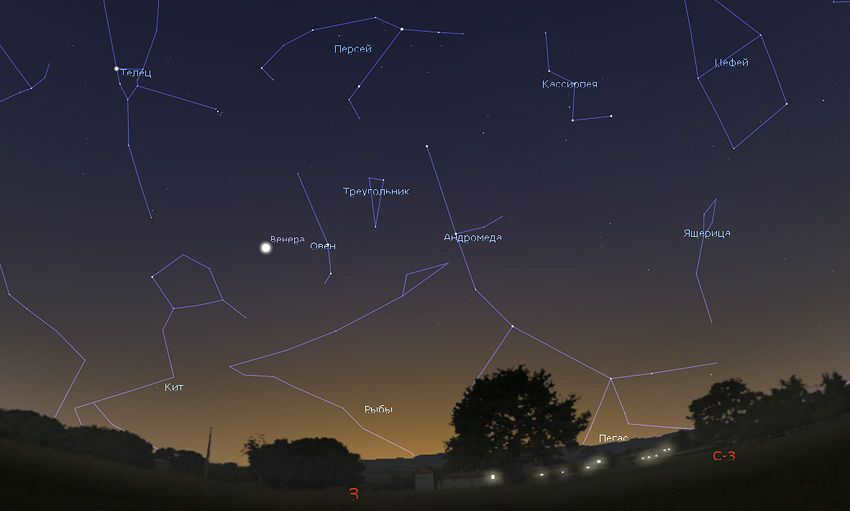
The starry sky during the early evening hours in March 2020 offers a captivating sight. If you look towards the west, you will notice a brilliant and sizable star amidst the backdrop of the evening twilight, surrounded by the constellations of fall. This remarkable celestial phenomenon is beautifully captured in the image above, courtesy of Stellarium.
While most of these constellations are typically not very bright, there is one exception in March 2020. This particular star shines so intensely that it can easily confuse individuals who are not well-versed in astronomy. So, what exactly is this dazzling object?
The answer is Venus, the brightest planet in our sky, second only to the Sun and the Moon. Throughout almost the entire month of March, Venus can be found in the constellation of Aries. Towards the end of the month, it transitions into the neighboring constellation of Taurus.
There are several constellations that can be seen in the western sky at night, including Perseus and Andromeda. Perseus has a shape that resembles an upside-down slingshot, with the brightest star, called Mirfak, located in the center. Andromeda, on the other hand, has its brightest stars forming a long chain that is almost perpendicular to the horizon.
In the city, the dim constellation Pisces is barely visible, and only a few stars in the constellation Keith can be seen, faintly twinkling near the horizon. Aries has only two relatively bright stars, which can be discerned in the city sky. The constellation Triangle is made up of three rather dim stars.
During the first three to four hours of the night in early March, these constellations will descend below the horizon. By the end of the month, only Aries, Triangle, and Perseus will remain visible. They will set within an hour and a half to two hours after dusk.
The southern sky
In the early evenings, the southern part of the sky is filled with the winter constellations. These constellations are likely well-known to everyone by now. The dominant presence in this view is Orion, the brightest constellation in the entire sky.
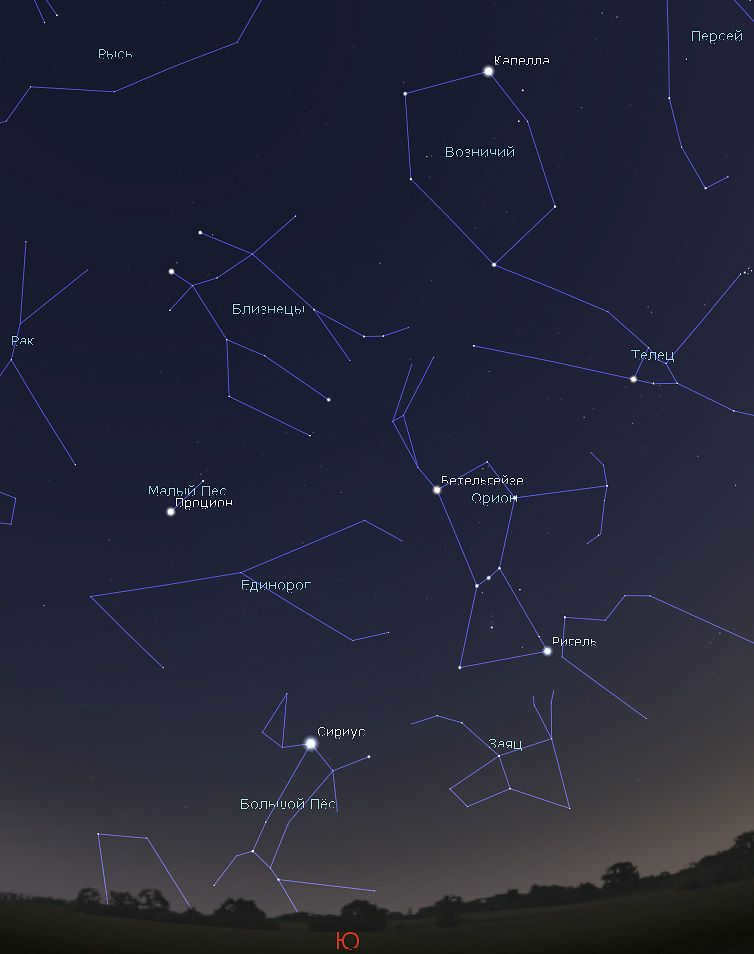
In the evening sky during the month of March, if you look towards the south, you can see a beautiful display of constellations. This view was created using Stellarium, a popular software for astronomical observations.
Located at the center of the constellation Orion, there are three stars with a magnitude of second. These stars form what is commonly known as Orion’s Belt. By extending a line downwards from the Belt stars, you will be able to spot Sirius, which is the brightest star in the entire night sky.
Due to its low position above the horizon, Sirius often appears to shimmer and shine in various colors. On the other hand, if you extend the line upwards from Orion’s Belt, you will come across the bright star Aldebaran and eventually reach the Pleiades, which is a cluster of stars that appear diffused.
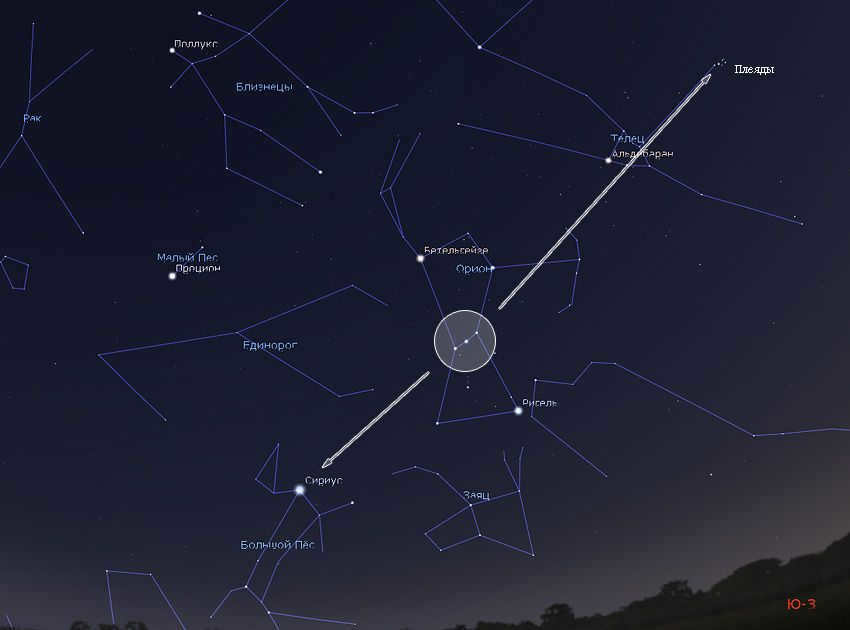
Since ancient times, Orion’s belt has been utilized as a guide to locate the most brilliant star in the night sky, Sirius, as well as the Pleiades. Image: Stellarium
The March Winter Hexagon or Winter Circle
The most luminous stars in the winter sky merge together to create a massive asterism, known as The winter circle or Winter Hexagon.
The highest point within this asterism is situated at Capella, a radiant star with a yellowish hue. It serves as the head of the Ascendant constellation, which takes on the form of an irregular quadrilateral. Just below Capella, three faint stars form a small isosceles triangle. This particular figure was referred to as the Goat by ancient civilizations (the name Capella itself translates from Latin as “goat”).
The bright star below Capella is the aforementioned Aldebaran. Take note of the star’s color, as it exhibits a distinct reddish hue.
Located on the outskirts of a group of faint stars is Aldebaran, which serves as the leader of the Taurus constellation. This group of stars, known as the Hyades, is a loosely arranged star cluster situated approximately 150 light years away from our planet. The Hyades cluster is notably shaped like a triangle or the letter V in Latin. Ancient Greek astronomers associated this cluster with the head of a bull, with Aldebaran representing the animal’s bloodshot eye. According to Greek mythology, the bull charges towards the hunter Orion, who retaliates by brandishing a club.
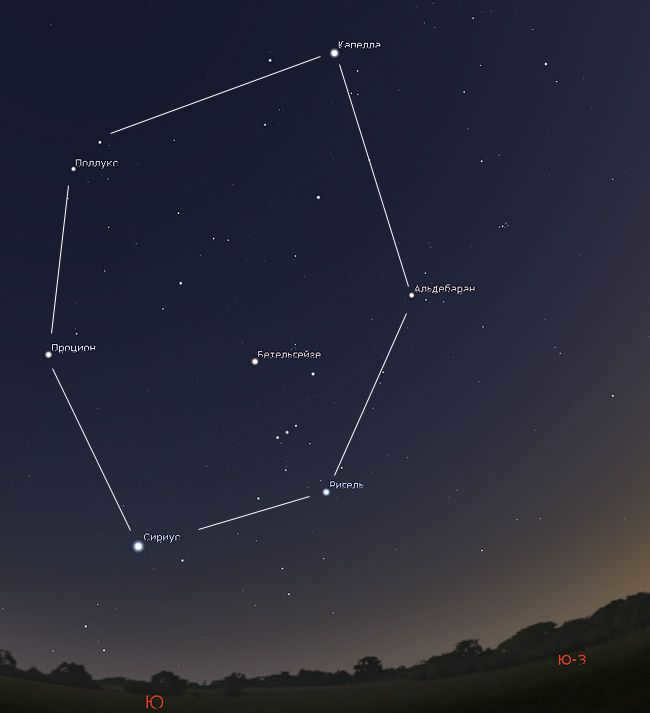
The grouping of the six brightest stars in winter is known as the Winter Circle or Winter Hexagon. In March, it can be observed in the evenings towards the south and later towards the southwest. Image: Stellarium
Two stars, specifically the beta and zeta stars of the Taurus constellation, represent the immense horns of the animal. The beta star of Taurus is also known as Nat or Elnath. Located next to the zeta star of Taurus is the well-known Crab Nebula (also referred to as M1), which is the remains of a supernova explosion that occurred in 1054.
Beneath and to the left of Aldebaran, the third star of the Winter Hexagon, is the luminous Rigel.
This star with a bluish-white color is located at the right leg of Orion. On the other side of the Belt, you can find the reddish Betelgeuse, which is situated at the hero’s left shoulder. Until recently, Betelgeuse was the only bright star in the winter sky that was not part of the Winter Hexagon (it is inside it). However, in 2019, Betelgeuse experienced a significant fade and went from being a first magnitude star to a second magnitude star. It is expected that Betelgeuse will regain its former brightness in 2020.
Sirius, which is the southernmost star in the Winter Hexagon, leads the constellation of the Big Dog. This constellation can be fully observed only in southern Russia.
Procyon is the fifth star in the Winter Hexagon. It can be found in the Lesser Dog constellation, which only has one other prominent star – Gomeisa. It is often referred to as the eastern boundary of the winter sky, as the area of spring constellations begins just beyond it.
The dim Unicorn constellation fills the dark expanse between Procyon, Sirius, and Betelgeuse. When away from city lights, one can observe a broad and faint stretch of the Milky Way in this region of the celestial sphere. The use of binoculars or telescopes will unveil a plethora of captivating star clusters!
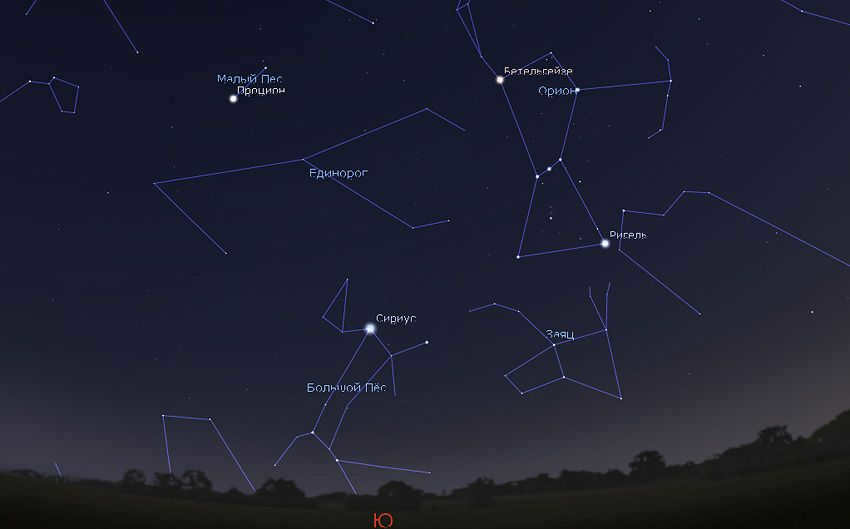
The Unicorn constellation is best observed in a moonless sky outside of urban areas. This dim constellation is intersected by the Milky Way! Image: Stellarium
The final star of the hexagon is Pollux, located in the Gemini constellation. Just above Pollux is the equally bright star Castor. These two stars serve as the primary features of the constellation.
The sky in the east
Do you recall that we are observing the evening sky in March? The sun has already set a few hours ago, and while it is dusk, it is not yet fully night.
Now let’s direct our attention towards the southeast and the east.
It is surprisingly dark in this direction. In the city, only one pattern stands out in this section of the sky – a rather large trapezoid formed by four stars. This particular formation has a magnitude of 1st, making it quite bright. It is known as Regulus. The other stars in this area have a magnitude of second, which means they are equally as bright as the stars in the Big Dipper.
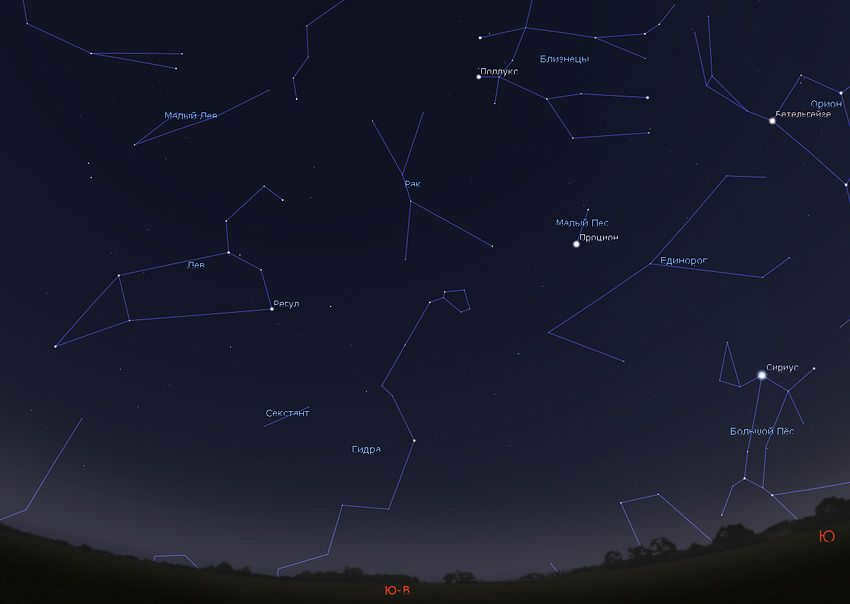
The Leo Trapezium and Regulus play the leading roles in the eastern part of the winter constellations. Image: Stellarium
This geometric shape represents the central feature of the Leo constellation. It is known as the Lion’s Trapezoid. On ancient maps, this shape symbolized the body of a reclining predator. The three faint stars positioned above Regulus represented its head. The stars of the head and the two stars on the right side of the trapezoid, including Regulus, create an asterism that resembles a question mark facing in the opposite direction. This formation is known as the Sickle.
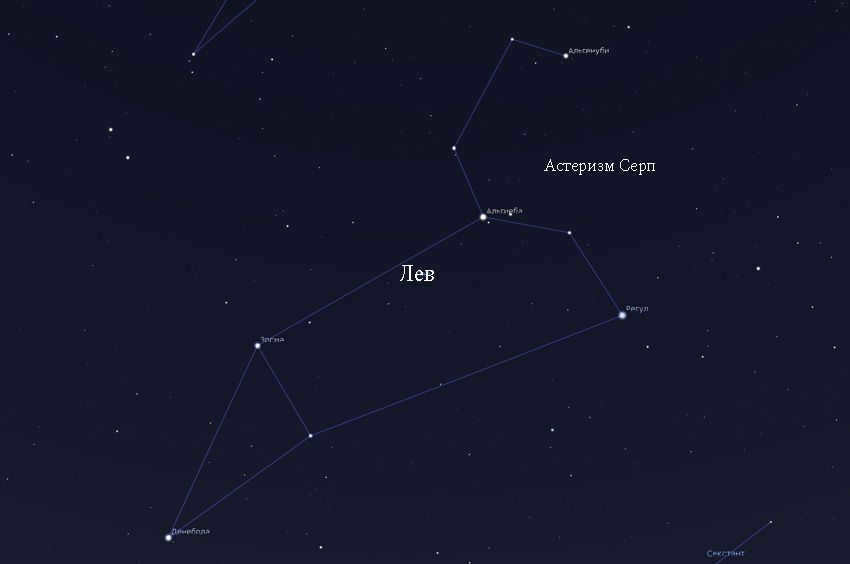
The Sickle asterism, consisting of the head of Leo and the star Regulus, can be observed in the night sky. Image: Stellarium
Leo constellation is one of the most prominent constellations in the spring sky. It serves as a crucial point of reference in this part of the celestial sphere.
However, in urban areas, only a few faint stars in the vicinity of Leo are visible. It is impossible to discern any recognizable patterns among them! To truly study the spring constellations, one must venture into a dark, moonless sky, away from the interference of street lights.
The Cancer and Hydra constellations
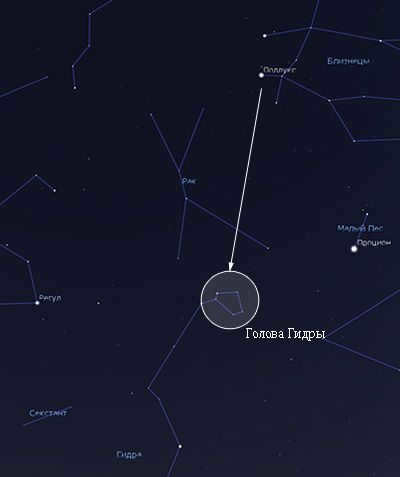
The Cancer constellation and the Hydra’s Head asterism can be best observed outside the city. It is situated between the stars Regulus and Pollux. Additionally, outside the city, you will have the opportunity to witness the main attraction of this constellation, the scattered star cluster Nursery.
To the south of Cancer, there is a small ring of faint stars known as the “Hydra’s Head” asterism. This can be located by drawing a line from Castor to Pollux and continuing downward.
Alfard is situated at a considerable distance from the shining city lights. Regulus, the closest brilliant star, can be found 23 degrees towards the northeast. Procyon, another sparkling celestial body, is positioned 30 degrees in the northwest direction. When observed together, they create a distinctive and easily identifiable triangular formation.
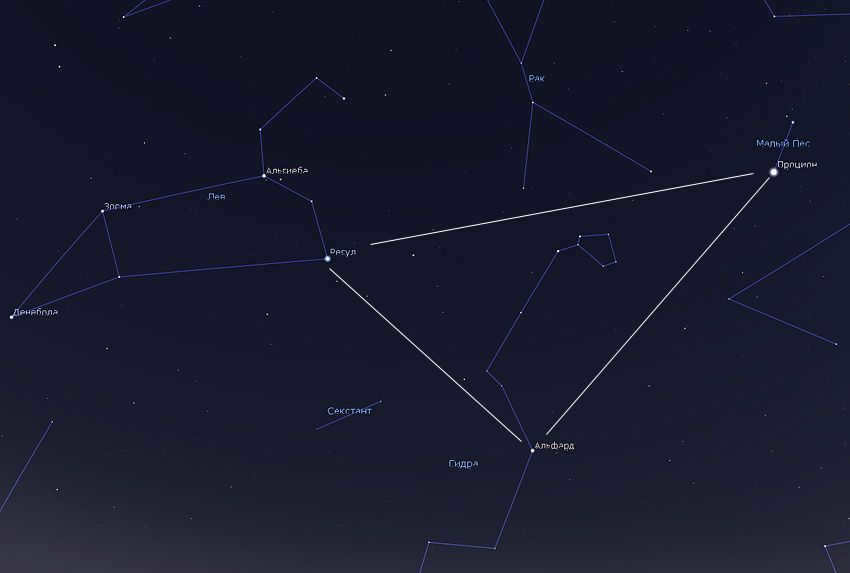
In the sky, there is a large triangle formed by Alfard, Regulus, and Procyon. This formation can be observed in the southeast during the evenings in March. The image is a representation from Stellarium.
Located to the north of Hydra is a relatively dull and unimpressive constellation known as Sextantus. Another faint constellation, known as The Bowl, can be seen rising in the southeast. This constellation is situated below the Trapezium of Leo.
Volopassus, Hound Dogs and Veronica’s Hair
Over in the eastern direction, one can spot a brilliant star that sits low above the horizon. This particular star goes by the name of Arcturus. It holds the distinction of being the most luminous star in the northern celestial hemisphere, as well as the fourth brightest star in the entire night sky. It’s worth noting that if one were to look directly above Arcturus, high up in the sky, they would see the iconic Big Dipper constellation. In fact, by extending the handle of the dipper downwards, it would conveniently point to this very star!
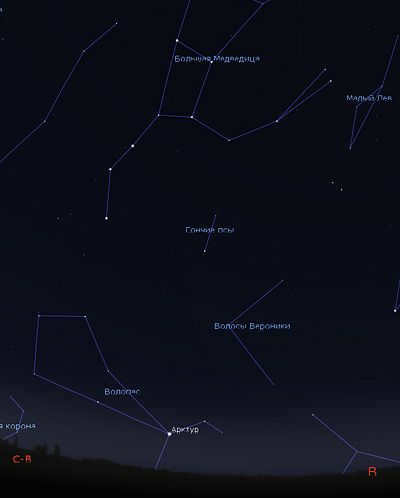
In the month of March, the eastern sky is adorned by the brilliant presence of Arcturus, the brightest star. To confirm your sighting of Arcturus, simply extend the arc of the handle of the Big Dipper towards the horizon. This celestial event can be observed during the evening hours. Image source: Stellarium
Arcturus acts as the guide for the constellation known as Volopassus, which exhibits a distinctive shape resembling either a kite or an ice cream cone.
The Northern Sky
If you reside at the latitude of Moscow or St. Petersburg, when you gaze north on a March evening, you will observe two brilliant stars positioned low above the horizon. The star on the right is brighter and is called Vega, while the star on the left is known as Deneb.
Indeed, these two stars form the Summer Triangle, which will ascend to a high position in the eastern sky in a couple of months and eventually migrate to the southern region of the sky during the summer. It is worth noting that at latitudes south of Kiev, the star Vega is already descending below the horizon. Likewise, in the southern parts of Russia and in Central Asia, Deneb also sets over the horizon.
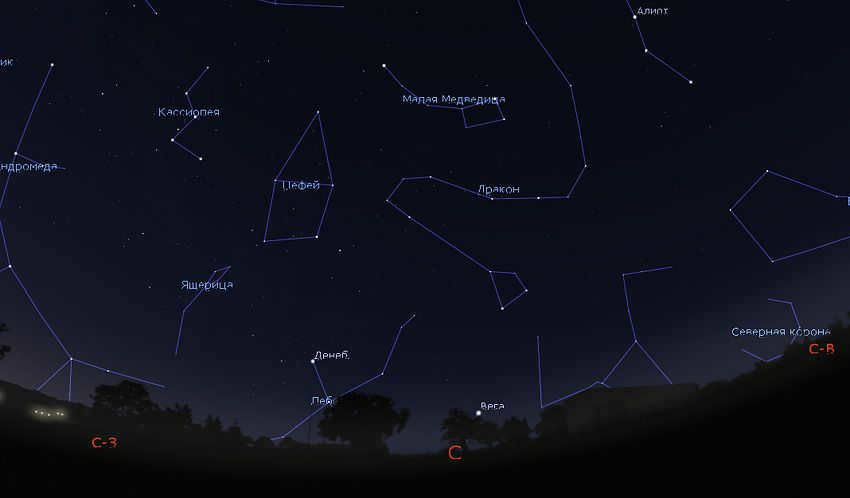
In the evening of March, you can enjoy the beautiful starry sky. Look towards the north to find the constellation. This information is provided by Stellarium.
Polaris is positioned almost exactly above the northern point of the horizon. The altitude of Polaris is the same as the latitude of your location. If you are observing in St. Petersburg, Polaris will be 60° above the horizon. For those in Moscow, the star’s altitude will be 55° 45′.
Polaris is a constituent of the Little Bear constellation. The primary formation within this constellation is the Little Dipper. The Little Dipper is considerably fainter than the Big Dipper’s Ladle. In city skies, only three of the Lesser Scoop’s seven stars can be reliably seen. These stars include Polaris, which is situated at the tip of the handle of the dipper, as well as the two stars that mark the front side of the dipper – Cohab and Ferkad.
There are two constellations, Cepheus and Dragon, located between Polaris and the Vega-Deneb pair. Cepheus resembles a house with a peaked roof, as if it was drawn by a child. The Dragon constellation is a long, curved chain of stars that stretches from the buckets of the Bears to Vega. It terminates in an irregular quadrangle known as the Dragon’s Head. The brightest star in the constellation, the gamma star of the Dragon, is located at the end of the head and appears to be facing towards Vega.
Finally, another small but noticeable star grouping can be found to the left of Cepheus, adjacent to the constellations Andromeda and Perseus. Its shape resembles the letter W in English or the inverted letter М in Russian. This grouping is known as the constellation Cassiopeia. By locating Cassiopeia in the night sky, you can easily locate other celestial objects such as the Andromeda Nebula, the constellation Perseus, the variable star Algol, and more during the summer, fall, and part of the winter. Make a mental note of this constellation as it can be observed throughout Russia without obstruction from the horizon.
March Night Sky: A Spectacular Display of Stars
As the clock strikes midnight, the majestic starry sky undergoes a remarkable transformation, shifting gracefully towards the western horizon. While the fall constellations bid us adieu, one constellation, Perseus, stands tall amidst the celestial tapestry. However, the Winter Hexagon, a dazzling formation of stars, continues to captivate our gaze. With Capella shining brightly in the far west, and Pollux and Procyon gracing the southwest, the night sky in March offers a truly mesmerizing spectacle.
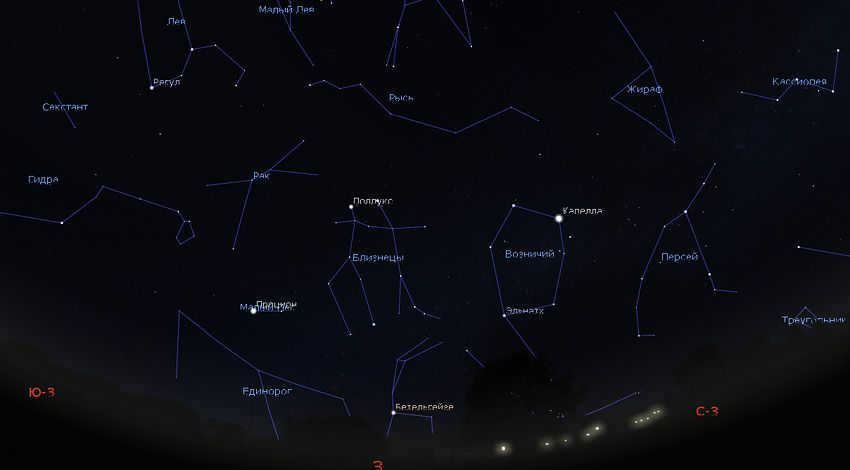
In the month of March, the night sky is filled with a breathtaking display of stars. To fully appreciate this celestial spectacle, it is best to venture out after midnight. Looking towards the west, you will be treated to a stunning view of the starry expanse. This captivating scene was captured using the Stellarium software.
Exploring the southern and southeast sky
In March, the southern part of the sky is adorned with an array of spring constellations. One prominent constellation is Leo, which forms a distinct trapezoid shape. Positioned high in the sky, Leo commands attention. Below Leo, you will find a dark region that is home to several other constellations, including Hydra, Sextant, Bowl, and Raven.
As you shift your gaze towards the southeast, a bright star catches your eye. This star is Spica, the alpha star of the Virgo constellation. To locate Spica, simply extend the arc from the handle of the Big Dipper towards the south, and you will find this dazzling celestial gem.
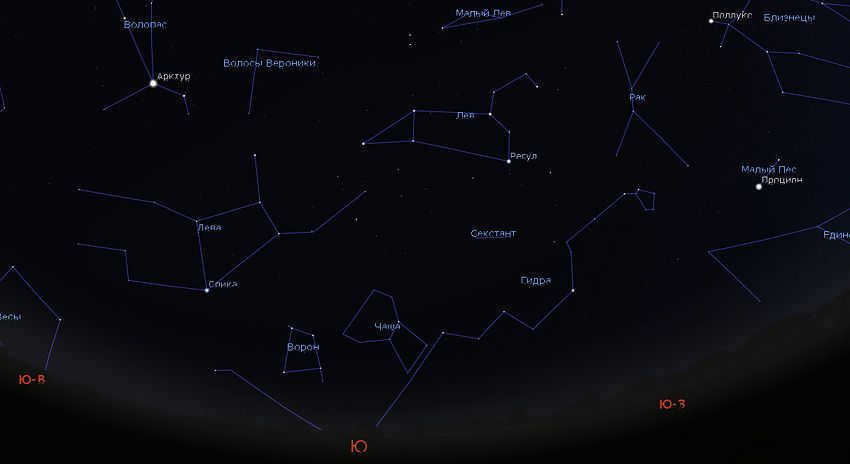
Observing the night sky in March reveals a beautiful sight. If you head towards the south, you will notice the constellation Virgo and its prominent star, Spica, in the southeast. This information is provided by Stellarium.
Although Virgo is one of the largest constellations in terms of area, it can be challenging to identify distinct features within it. However, one notable aspect is the irregular quadrangle formed by the stars Porrima (Virgo gamma), Virgo delta, and Virgo zeta, along with Spica. Additionally, a conspicuous star called Windemiatrix can be seen above this quadrangle.
Regulus, Arcturus, and Spica are three incredibly luminous stars visible in the springtime celestial dome. When these stars are joined together by lines, they form a colossal celestial triangle. This triangle is so vast that it proves to be of little practical use as a navigational reference. To address this issue, astronomers have designated an alternative figure in the spring sky, known as The Virgo Diamond.
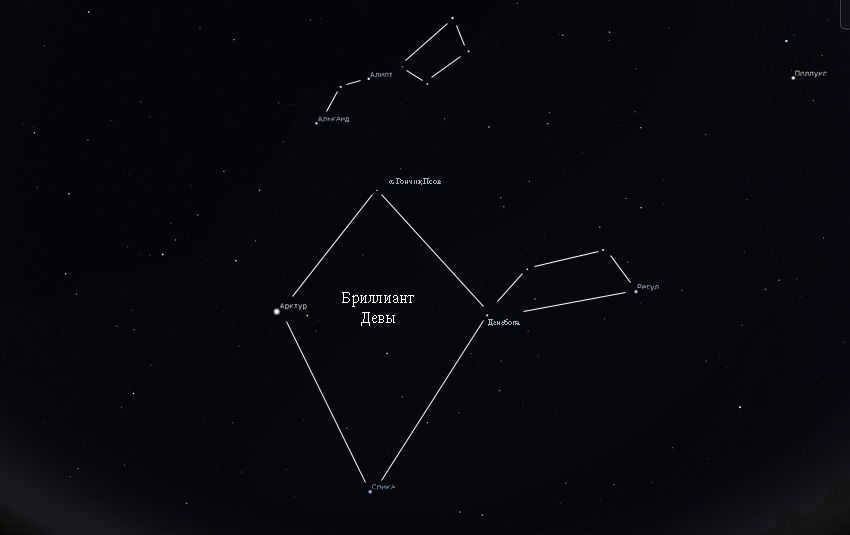
The Virgo Diamond, Leo’s Trapezium, and the Big Dipper are celestial formations that can be observed in the night sky. The Virgo Diamond is a quadrilateral shape that includes the stars Spica, Arcturus, Alpha of the Hound Dogs, and Denebola, which is the leftmost star in Leo’s Trapezium.
What makes the Virgo Diamond noteworthy is that it encompasses a section of the sky that is home to a multitude of galaxies. These distant stellar islands can be seen through amateur telescopes, providing a unique opportunity for stargazers.
In the eastern part of the night sky during March, the rising summer constellations dominate. Among them, the compact constellations of the Northern Crown and Lyra stand out. These formations are separated by the vast constellation Hercules, which is not easily visible in urban areas.
In the northern part of the sky, you can find the constellations of the Swan, Lizard, Cepheus, and the Little Bear, with Polaris serving as the focal point of the latter.
This leads to the question, where can we find the Big Dipper? During the nighttime in March, it is positioned directly above us, almost at the zenith!
March’s Early Morning Sky
Although the days start to become longer than the nights in March, the period of darkness still lasts for over 10 hours by the end of the month. That’s nearly half a day! During this time, the sky completes almost half a rotation. As a result, the stars and constellations that were in the northern part of the sky earlier in the evening will now be found in the southern part of the sky before dawn in March. And vice versa.
All the constellations of winter, which were previously visible in the southern sky during the early evening, have now disappeared below the horizon by morning. Only Capella, one of the bright stars of the Winter Hexagon, remains – it can be seen low on the northern horizon.
Looking towards the horizon in the western sky, you can spot the constellation Leo as it gracefully slopes downward. Just above Leo, you’ll find the Big Bucket constellation, seemingly observing everything below.
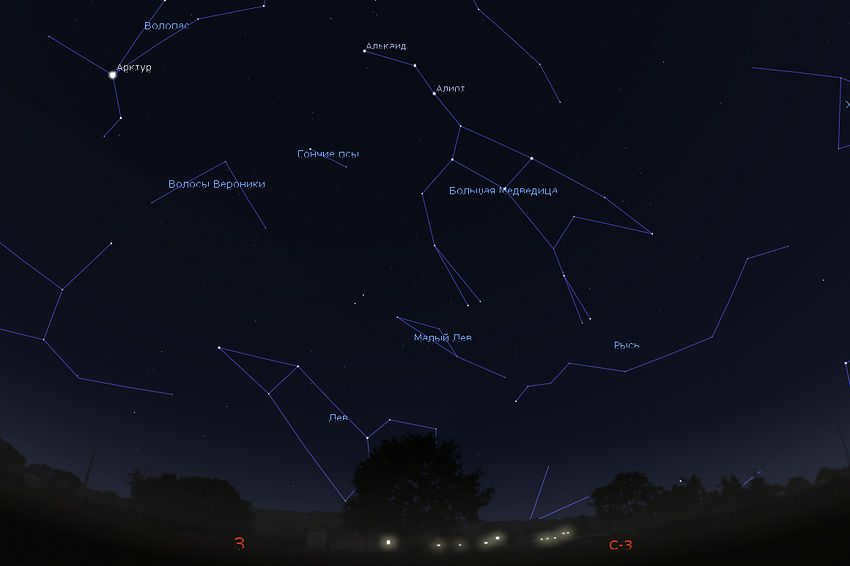
On a March morning, you can observe the beautiful starry sky. If you look towards the west and northwest, you will see the spring constellations, including Volopassus and Virgo. Take note of the “diamond” made up of 3rd magnitude stars that is visible low on the horizon to the east of Spica and the constellation Virgo. Another zodiacal constellation that you might spot is Libra. It is also known as a spring constellation and the best time to observe it is in May.
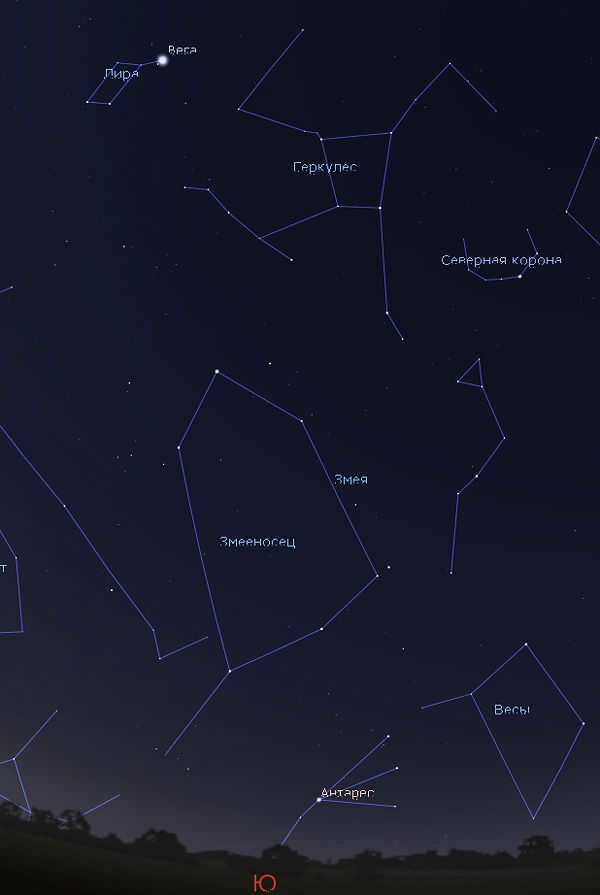
In the morning sky of March, the southern portion is filled with the constellations of summer, including Serpent, Hercules, Scorpius, and Snake. Image: Stellarium
The entirety of the southern sky is dominated by the summer constellations Serpentor and Hercules, as well as the smaller constellations of Serpent and Northern Crown (on the right), Lyra and Serpent (on the left). Serpentor is the only constellation in the sky that is divided into two sections: the western portion is known as Serpent’s Head, while the eastern portion is called Serpent’s Tail. In the middle, Serpentor holds a twisting snake in his hands.
Just above the horizon, below the Serpentor constellation, there is a rather brilliant star. It goes by the name of Antares, and it is the primary star of Scorpius. In moderate latitudes, only a partial view of the Scorpius constellation can be seen: at the latitude of Moscow or St. Petersburg, three other bright Scorpius stars can be observed, arranged in a fan to the right (west) of Antares.
The full constellation of Scorpius can only be seen in southern Russia.
As the light begins to emerge, a bright star can be seen low above the horizon, to the east of Antares. This star is none other than the planet Jupiter, which, in March 2020, can be found in the Sagittarius constellation. In the same constellation, alongside Jupiter, two other planets, Mars and Saturn, can be found. These planets are not as bright and may be more challenging to spot. However, Jupiter can serve as an excellent guide when attempting to locate them.
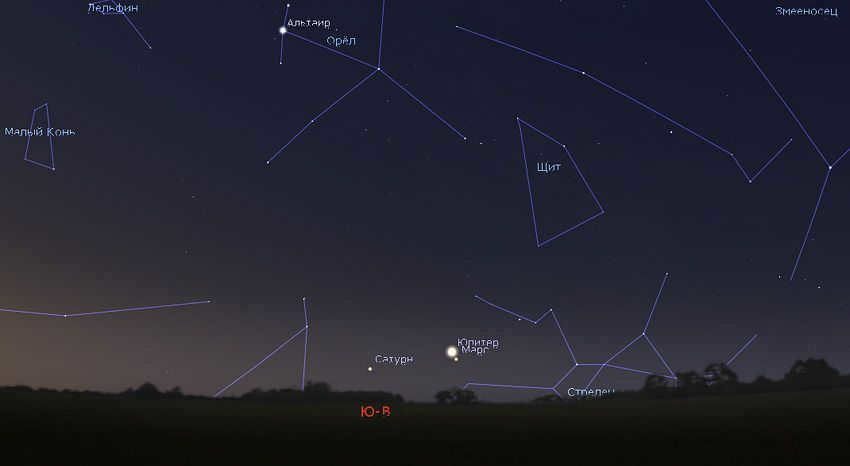

In the early morning of March 20, 2020, you can witness a captivating celestial event as Jupiter, Mars, and Saturn align in the sky. The diagram above shows the height of these planets above the horizon for the latitudes of Moscow and St. Petersburg. It’s worth noting that in the southern regions of Russia, the planets will be positioned a few degrees higher. This information, courtesy of Stellarium, allows you to plan the best time to observe these exquisite constellations.
The March morning sky towards the southeast
Take a moment to observe the southeastern direction. Up above, you’ll find a captivating sight – a magnificent triangle composed of three brilliant stars. This celestial formation is known as the renowned Summer Triangle, which is sometimes called the Great Summer Triangle or the Summer-Fall Triangle.
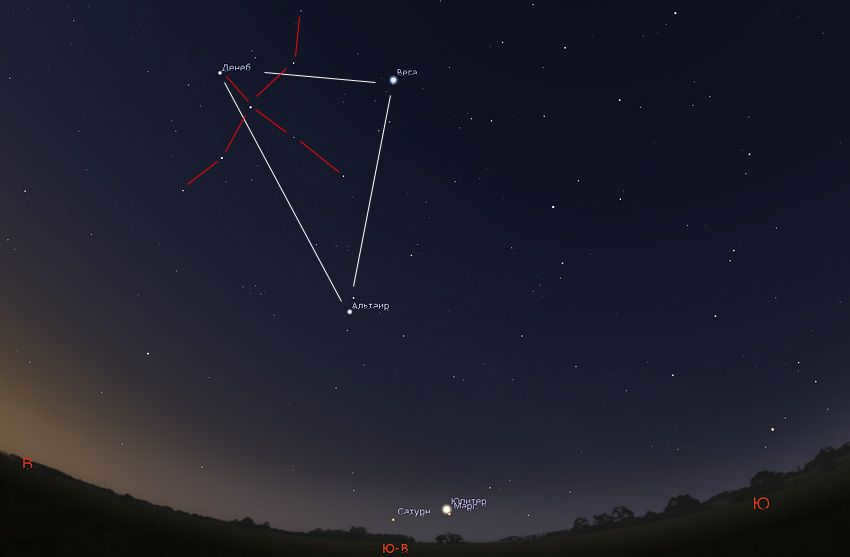
In the March morning sky, you can spot the Summer Triangle and the constellation Swan (its figure is highlighted with red lines). This image was captured using Stellarium.
The two stars at the top of the figure are Vega and Deneb, as mentioned earlier. Altair, the star in the southern part of the triangle, completes the trio. These three stars are part of three distinct constellations. Vega represents the head of the small constellation Lyra, which is characterized by a small parallelogram formed by stars of 3rd and 4th magnitude positioned just below Vega.
The constellation known as the Eagle bears a resemblance to the Swan in terms of its pattern, although it consists of considerably fainter stars. Additionally, the star Altair can be found in the bird’s tail.
Heading towards the eastern part of the celestial sphere, we encounter the ascending constellations of autumn – Pegasus, Andromeda, and Triangle. Situated above them is Cassiopeia, a constellation characterized by its distinctive W shape.
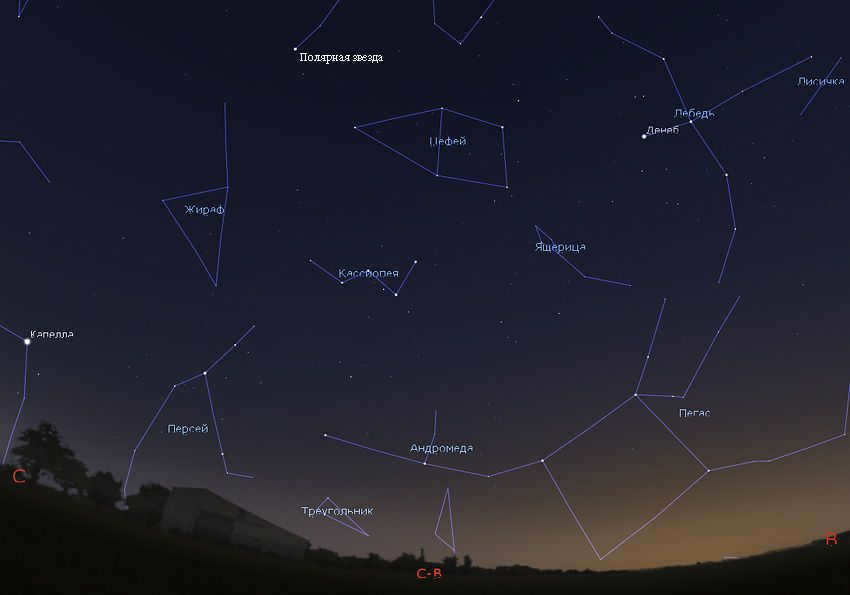
Observing the starry sky in March is best done in the morning, specifically in the north and northeast direction. The image provided is a representation of the sky created using Stellarium software.
Summary
Thus, we have explored the starry sky in March 2020 during the evening, night, and morning hours before dawn. The arrangement and drawings of constellations remain consistent over time, making this description applicable to March in subsequent years. The only variation lies in the positions of the planets. In March 2020, Venus shines brightly in the evening sky, while Mars, Jupiter, and Saturn are visible in the morning sky. (Mercury can also be observed in the mornings of March, but only in southern Russia.) In future years, the planetary positions will differ. It is important to keep this in mind if you are reading this article after 2020.
A comprehensive overview of the current positions and visibility of the planets can be accessed in the article titled “Planets in March 2020”.
For information on astronomical events and phenomena occurring in the sky during March 2020, please refer to this resource.
The zodiacal constellation Aries is widely recognized for its association with the ram, as symbolized by its depiction of ram horns. The Latin name for Aries, “Aries”, directly translates to “ram”.
According to an ancient Greek myth, the ram was responsible for sending the goddess of clouds, Nephela, to rescue two children named Phrixus and Gella from their wicked stepmother. The ram carried them across the Dardanelles Strait to Colchis, but unfortunately, Gella fell while Phrixus successfully reached the shore. Despite its unfortunate fate, Phrixus sacrificed the ram to the gods in gratitude for his rescue and presented its skin to the king of Colchis. This skin was then hung in the temple and became known as the Golden Fleece. Subsequently, the renowned Argonauts embarked on a mission to obtain it.
The constellation Aries, as we now recognize it, was introduced into the night sky by Claudius Ptolemy in 140 AD when he included it in his extensive astronomical work, “Almagest.”
The constellation Aries can be found in the northern hemisphere and covers an area of 441 square degrees, making it the 39th largest out of the 88 constellations. It is easily visible all across Russia as it appears high above the horizon. The Sun is in Aries from April 19 to May 13, making the autumn months, especially November, the perfect time to observe this constellation.
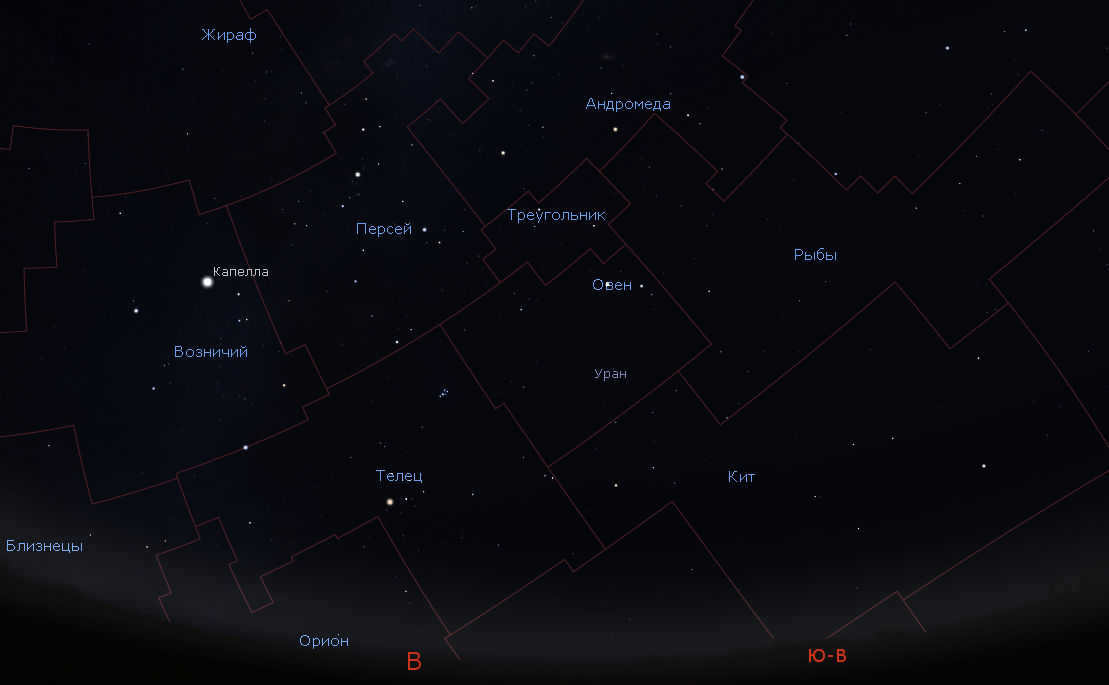
The Aries constellation can be observed in the autumn sky.
Although the Aries constellation does not contain any bright stars that are brighter than 2m, it is still easily identifiable due to its proximity to more famous and distinct constellations. It can be found to the left and below the well-known square of Pegasus, and under the constellations Andromeda and the small Triangle. On its left and above, it is bordered by Perseus, and its left border connects with the Taurus constellation. Additionally, it is located very close to the easily recognizable Pleiades cluster.
Bright stars in the constellation Aries
This constellation does not have any exceptionally bright stars. However, it does have three prominent stars that are brighter than the rest – Hamal, Sheratan, and Mezartim. These stars are located close to each other and form a nearly straight line. They are designated as α, β, and γ, respectively. All three stars can be found at the upper edge of the constellation, just below the Triangle, and stand out clearly against the backdrop of fainter stars. Now, let’s take a closer look at these stars.
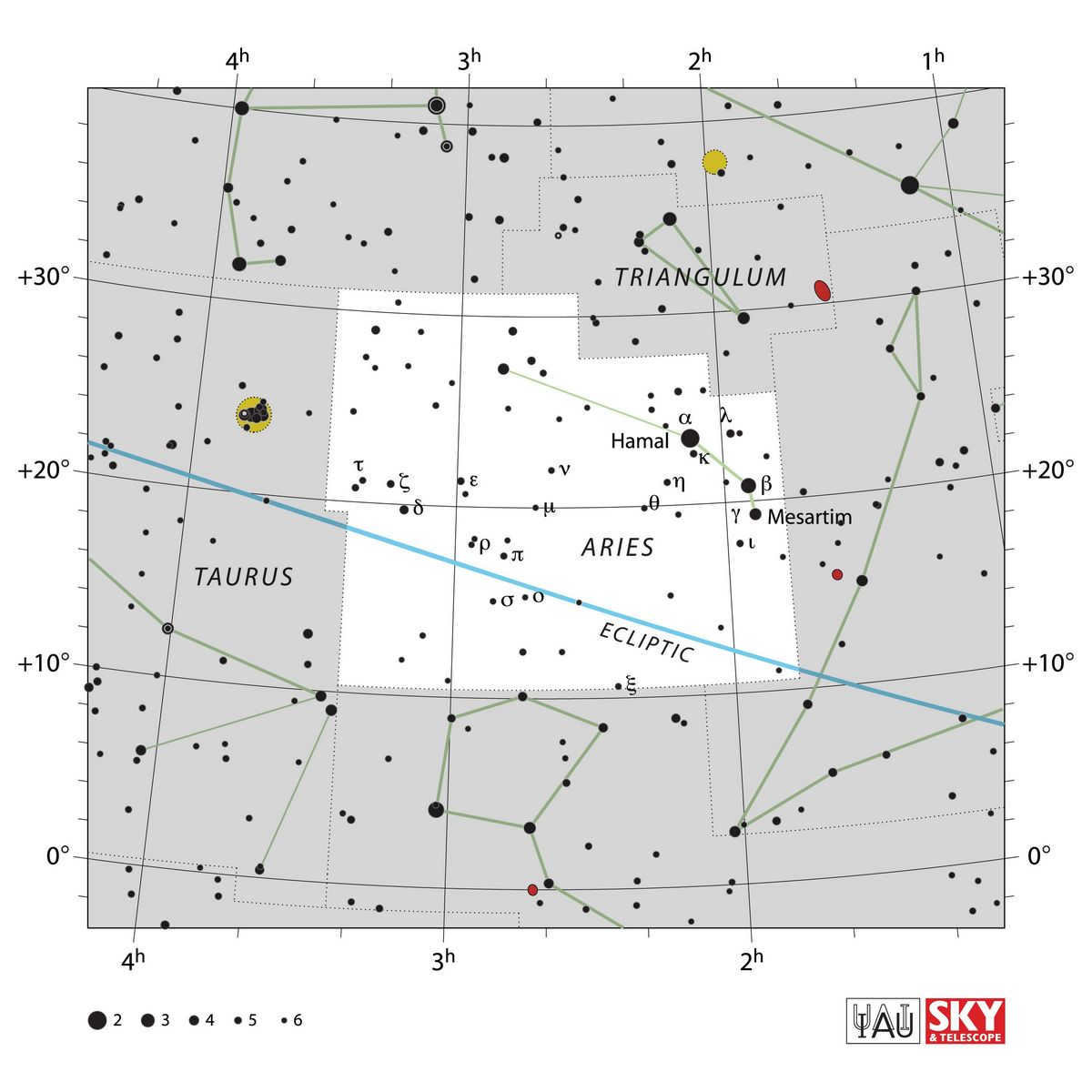
The alpha star of Aries is Hamal
Hamal, despite having a luminosity of only about 2.0m, is the brightest star in the constellation of Aries. It ranks as the 50th brightest star in the Earth’s sky. However, it is an orange giant of class K2 III. It is located approximately 66 light-years away.
Compared to the Sun, Hamal is significantly larger with a cross-section that is 15 times bigger. Despite this, it is only 2 times heavier in terms of mass. The surface temperature of Hamal is slightly colder than the Sun, measuring at 4590 K. However, due to its massive surface, Hamal emits approximately 91 times more light than the Sun.
One interesting fact is that in 2011, a planet was discovered at Hamal that follows an elliptical orbit around a star, ranging in distance from 0.9 to 1.5 astronomical units. This planet has a period of 381 days and is exceptionally large, with a mass at least 1.8 times that of Jupiter.
Beta Aries is Sheratan
Sheratan, which is the second brightest star in the constellation, has a luminosity of 2.65m. Through parallax measurement, its distance has been calculated to be 59.6 light-years. Despite its seemingly ordinary appearance, this star is actually a fascinating and tumultuous world.
Sheratan is an example of a binary star system, where two stars orbit each other closely. The stars are so close together that they cannot be distinguished as separate objects in any telescope. This duality was first discovered through spectroscopy at Mount Wilson Observatory. However, due to the dominance of the larger star’s spectrum, little is known about the smaller star. The two stars complete a full revolution around their common center of gravity in just 107 days.
The main star in this system is significantly larger than our Sun, weighing in at 2.34 times its mass. It also radiates 23 times more energy than the Sun. This main star is quite hot, with a surface temperature of 9,000 K.
The second star in the system is smaller and comparable in size to the Sun. It has a mass that is 1.3 times greater than the Sun’s and emits 1.3 times more luminosity.
Scientists speculate that in the span of several million years, the massive star situated in the Sheratan system will undergo a transformation into a red giant. Throughout this process, it will gradually expand in size and decrease in density. Subsequently, due to the gravitational pull within this proximity, a transfer of matter will initiate from the larger star to the smaller star, consequently leading to a reversal in their respective roles.
Mesartim, a gamma-ray in the constellation Aries
Mesartim, the third brightest star in the constellation, has a luminosity of 3.86m. However, it is located at a distant 164 light years away.
In actuality, Mesartim is a binary star system with a separation of 7.6 angular seconds. This means that even in a small telescope, you can observe the two stars as distinct entities. The first observation of this phenomenon was made by Robert Hooke in 1664, who was astounded by its uniqueness. The two stars are widely separated from each other and have an orbital period of 5000 years.
The primary star in the system is almost twice the size of the Sun and exhibits variability in its luminosity, with fluctuations of 0.04m occurring every 2.61 days.
Galaxies in the Aries Constellation
In the Aries constellation, there are a variety of galaxies, however, many of them are dim and necessitate a sizable telescope to locate. Nevertheless, you can still attempt to spot a few of them using a medium-sized instrument.
NGC 772 Galaxy
This galaxy is situated approximately 130 million light years away. Its magnitude in the night sky is 11.3m. While it shares the characteristic of being a spiral galaxy with our own Milky Way, upon closer examination, you will notice a key distinction – the absence of a prominent bar-like structure from which the spiral arms emanate.
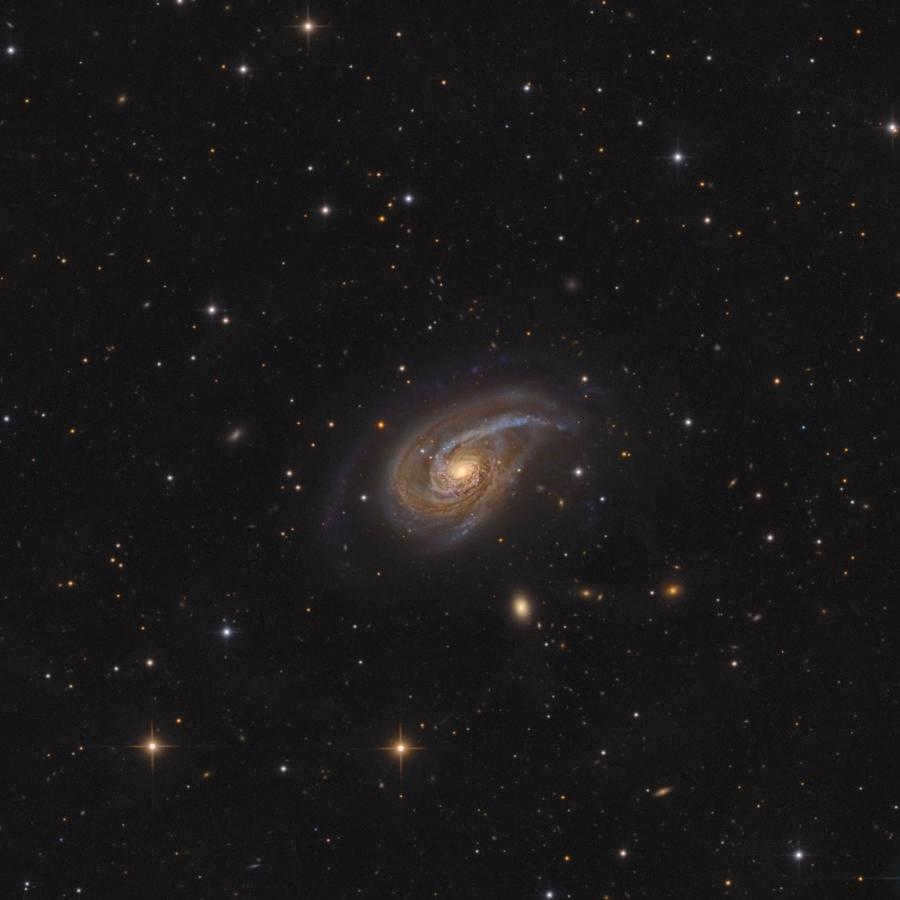
Galaxy NGC 772, captured by Andrei Ioda, is a stunning celestial entity. You can find the original image at http://astro.ioda.by/ngc-772.
An interesting feature of this galaxy is the notable distortion and elongation of one of its spiral arms. This peculiar shape is the result of the gravitational pull exerted by the nearby dwarf companion galaxy NGC 770.
NGC 772 is an impressive cosmic structure, being twice the size of our own Milky Way galaxy. Its diameter spans a massive 200,000 light-years. Furthermore, this galaxy experienced two supernova explosions in 2003, adding to its already captivating nature.
Galaxy NGC 972
This peculiar galaxy has a luminosity of 12.1m in the sky of our planet. Its distinctive feature is the high level of star formation occurring throughout its expanse as a result of the abundance of free gas. It is likely that this galaxy recently underwent a merger with another gas-rich galaxy, which also accounts for its wispy structure – the spiral disk has not fully regenerated yet.

There are also other galaxies located in the Aries constellation:
- NGC 1156 – an irregular, Magellanic-type galaxy with a magnitude of 12.3m.
- NGC 697 is a spiral galaxy with a magnitude of 12.7m.
As you can observe, even in the seemingly unattractive area of the sky occupied by the Aries constellation, there are fascinating celestial objects that are worth discovering and observing. We wish you successful stargazing experiences. By the way, a convenient star atlas will assist you in studying constellations – you can download and print it using a printer.
The topic of the twelve constellations within the zodiac circle is captivating and perpetually pertinent. One of these clusters of stars was known as Aries in ancient times. Astronomers have consistently taken note of this celestial entity, as the observations made on the Aries constellation have been of great significance to distinguished scientists. For numerous individuals, it marked the commencement of a journey towards remarkable scientific accomplishments.
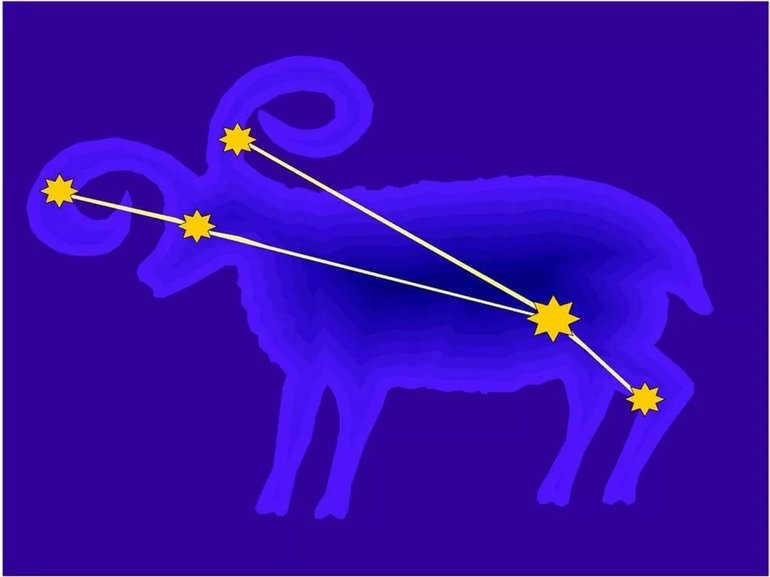
Myth and Truth
In the ancient city of Orchomena in Boeotia, there was a fascinating tale of love and betrayal. The ruler, Athamantes, was once married to the beautiful and ethereal goddess of clouds, Nephela. Together, they bore two children, Phrixus and Gella. However, as time passed, the king’s heart grew restless, and he left Nephela to be with another woman named Ino, whom he eventually married.
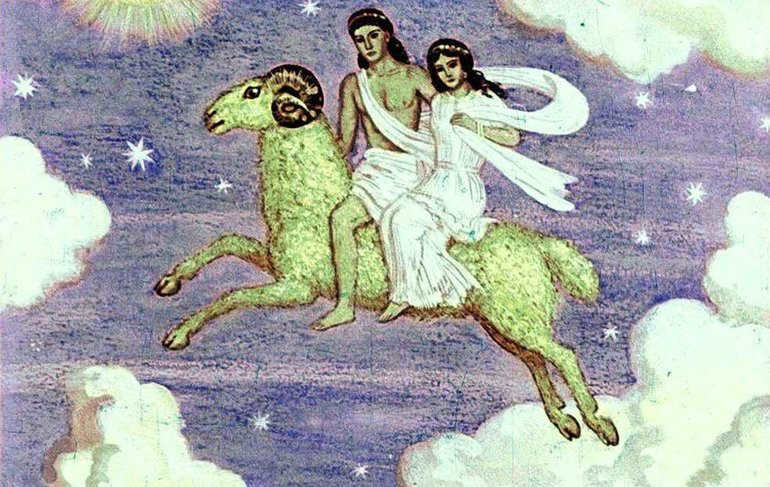
Shortly thereafter, Ino became enamored with Phrixus and began to torment him. However, Phrixus did not return her affections. In a fit of offended anger, Ino devised a plan to kill her brother and sister as an act of revenge.
Ino cunningly deceived the women of Orchomenus with her sly advice, causing them to sow dried grain, which ultimately resulted in crop failure and famine. Athamantes, upon learning of this, sent representatives to Delphi for guidance. Unfortunately, these representatives were bribed by Ino and manipulated the divination to suggest that sacrificing children would appease the gods.
Just as the sacrificial knife was about to fall upon the unfortunate victims, Nephela intervened by sending a golden-horned lamb to rescue Phrixus and Gella. Carrying them on its back, the ram soared through the sky to the far reaches of the world – Colchis.
While soaring above the ocean, the terrified Gella descended rapidly and met her demise in the depths. The ancient Greeks bestowed the name Gellespont (sea of Gella) upon this body of water, which is now known as the Dardanelles strait. Phrixus, on the other hand, safely reached his intended destination. In Colchis, the young man who had been saved performed a ritual sacrifice of a lamb and hung the precious golden fleece within a cave. Zeus later immortalized the ram by placing it in the heavens. The legendary tale of the Argonauts is closely intertwined with the fabled golden fleece.

A more recent tale regarding the constellation Aries is associated with the deity Dionysus. While wandering through the African desert, Dionysus became lost, but was guided back on track by a helpful ram. In gratitude, the god of winemaking immortalized his rescuer in the night sky.
In ancient Babylonian records, the name Aries was adopted by Cleostratus of Tenedos, an astronomer who lived during the late 6th century to the early 5th century BC. It is believed that Cleostratus named all the signs of the zodiac.
Unique Characteristics of the Aries Constellation
The Aries constellation is surrounded by two other zodiac clusters – Pisces to the east and Taurus to the west. To the north of Aries lies the Triangle constellation. Additionally, in close proximity to Aries is the Keith cluster, which the authors of this description provide a more detailed account of.
Aries does not resemble any specific geometric figure, but the ancient Greeks, known for their vivid imagination, interpreted the chaotic pattern of the horns and the outline of a ram within this constellation. Notably, there are three prominent stars in the configuration that play a key role in its formation:
When it comes to observing the Aries star set, Autumn is undoubtedly the optimal time. This can be done throughout Russia, particularly during the long nights of October and November. The Sun passes through Aries from the end of the second decade of April (19.04) to mid-May (13.05).
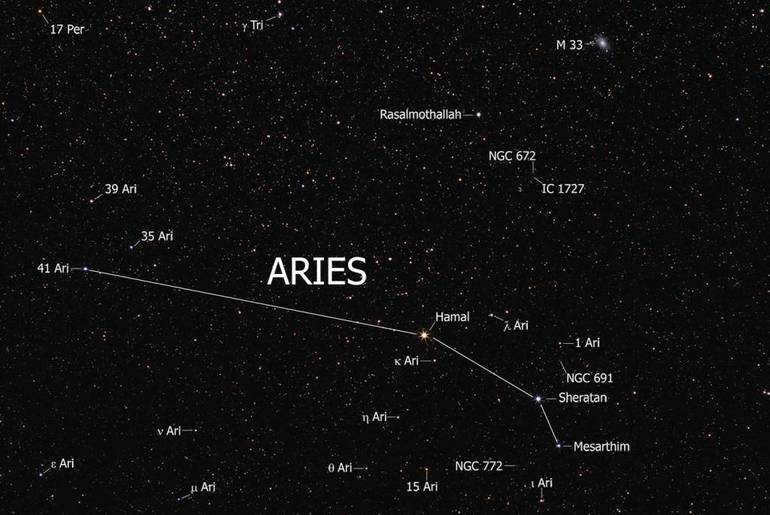
Interesting Facts
Just like any other celestial body that has been observed for centuries, the constellation Aries has accumulated a wealth of fascinating information. This information includes details about its changing coordinates over time, its physical characteristics, and the presence of various mysterious objects:
- During the time of Ptolemy, this star cluster marked the point of the vernal equinox.
- The brightest star in the Aries constellation, Alpha Gamal, is only the 48th brightest star visible in the night sky.
- Aries covers an area of 441 square degrees, ranking 39th in terms of size among all constellations.
- There are four galaxies located within the Aries constellation, including three spiral galaxies and one dwarf galaxy.
- The human eye can perceive approximately 50 stars in the arrangement, although they are all relatively faint. Among these celestial bodies, 5 of them have accompanying satellites.
Throughout history, people have been familiar with this group of astronomical objects, and their existence has given rise to numerous captivating myths and legends. Aries, occupying a significant position in the celestial sphere, has been incorporated into the zodiacal circle. Over time, Aries has undergone changes in its position, which can be attributed to the precession – a gradual shift in the Earth’s axis of rotation.
If you are interested in learning more about the constellation Aries, you can access and download a comprehensive report-presentation on this topic. The presentation consists of 11 slides and can be viewed using the provided player. Feel free to share this valuable resource with your friends through social media buttons and consider adding our presentation site to your bookmarks for future reference!
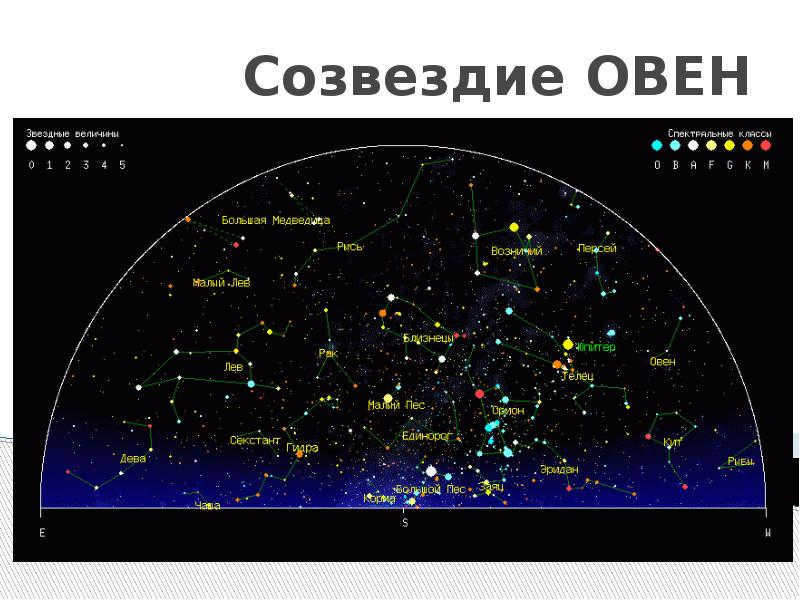
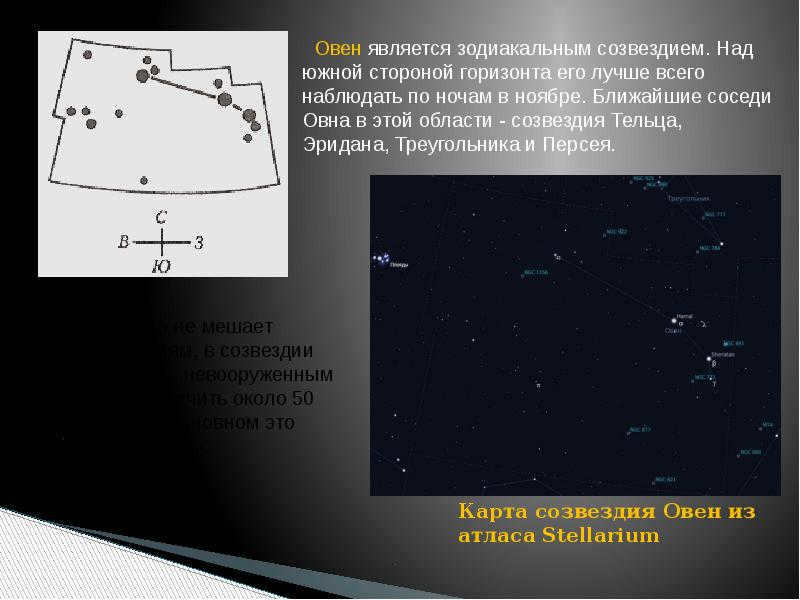

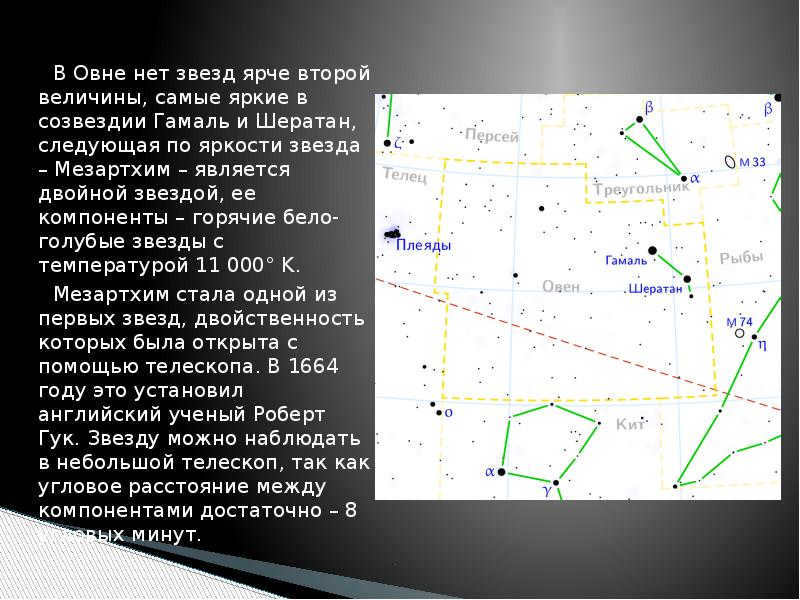
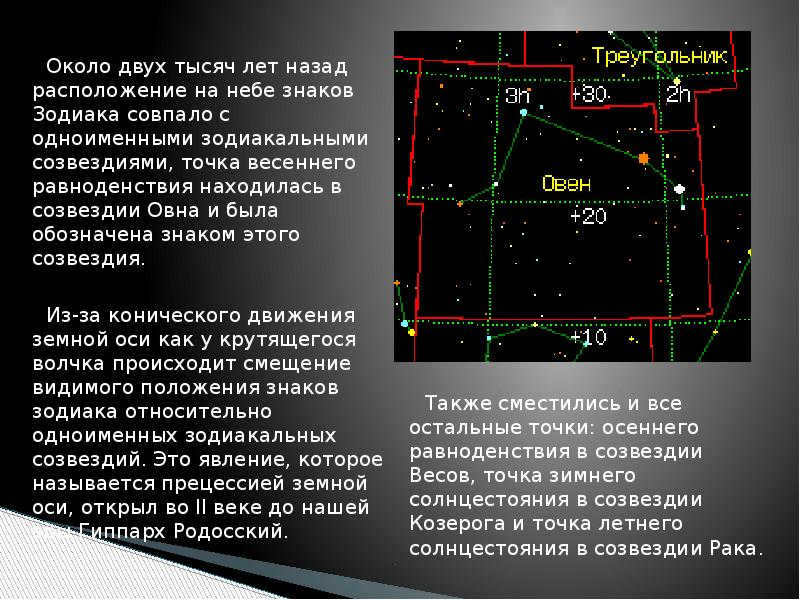


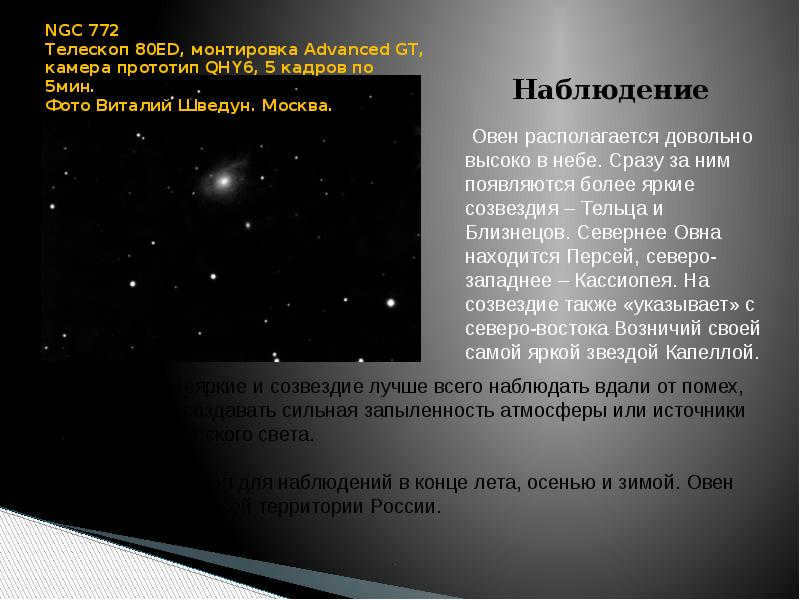



The brightest stars in Aries are alpha, beta, and gamma, which are of second, third, and fourth magnitude, respectively. These stars are arranged in a small arc that catches the attention, while the less bright stars surrounding them are scattered in a random manner, without forming any distinct geometric shape. The alpha, beta, and gamma stars of Aries, with magnitudes second, third, and fourth, respectively, create an arc that stands out, while the other, fainter stars are scattered in a way that does not create any recognizable pattern.
In the constellation Aries, there are no stars that are brighter than second magnitude. The two brightest stars in this constellation are Gamal and Sheratan. The next brightest star, Mezarthim, is actually a double star system. Its two components are hot blue-white stars with a temperature of 11,000° K. Mezarthim was one of the first stars to be discovered as a binary system using a telescope. This discovery was made by the English scientist Robert Hooke in 1664. If you have a small telescope, you can observe Mezarthim as the angular distance between its two components is 8 angular minutes.
Constellation OVEN Latin Name: Aries (gen. n.: Arietis) Abbreviation: Ari Symbol: ram Right Ascension: from 1h 40m to 3h 22m Declination: from +9° 55′ to +30° 40′ Area: 441 square degrees (39th place) Brightest stars (magnitude: 1h 40m to 3h 22m).
Most fascinating objects γ Aries is a binary system comprised of two stars of magnitude 4.8m and 4.8m. λ Aries is a binary system, easily observable in amateur telescopes. It consists of stars of 5th and 7th magnitudes. π Aries is a blue-white double star of 5th magnitude and can only be resolved at high magnifications. TT Aries is a variable star that belongs to the eruptive group. Over the past 50 years, its luminosity has changed from 9.5 to 12m. In 1982, the luminosity dropped to a critical value and became 16m. This star is a binary star with an orbital period of 3.3 hours.
NGC 877, a spiral galaxy of Sc class, is positioned in close proximity to the star 19 Aries, making it one of the most captivating objects to observe. With a brightness of 11.8m and angular dimensions measuring 2.3′ x 1.8′, NGC 877 offers a fascinating sight for astronomers and stargazers alike. On the other hand, vdB 16 stands out as a radiant reflecting nebula situated in the far corner of the Aries constellation, where it intersects with the constellations of Taurus and Perseus. While vdB 16 showcases a soft blue hue, its brightness is relatively subdued. The nebula’s angular dimensions are recorded at 11′ x 5.0′.
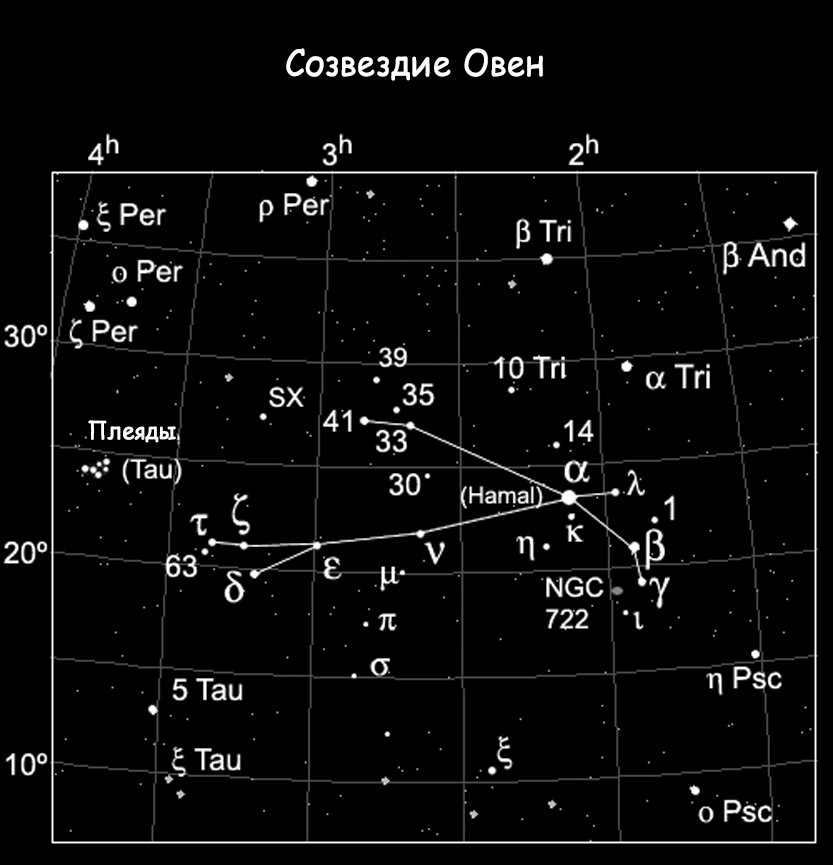
Aries is undeniably one of the most well-known constellation in the zodiac, despite lacking any stars brighter than second magnitude. Although mostly composed of faint stars, it is still possible to observe at least 50 stars within Aries, even with the naked eye, provided there are no obstructions. The primary stars in this constellation are Hamal, Sheratan, and Mezarthim, which are referred to as second, third, and fourth magnitude stars in astronomy.
One of the most well-known constellations in the Zodiac
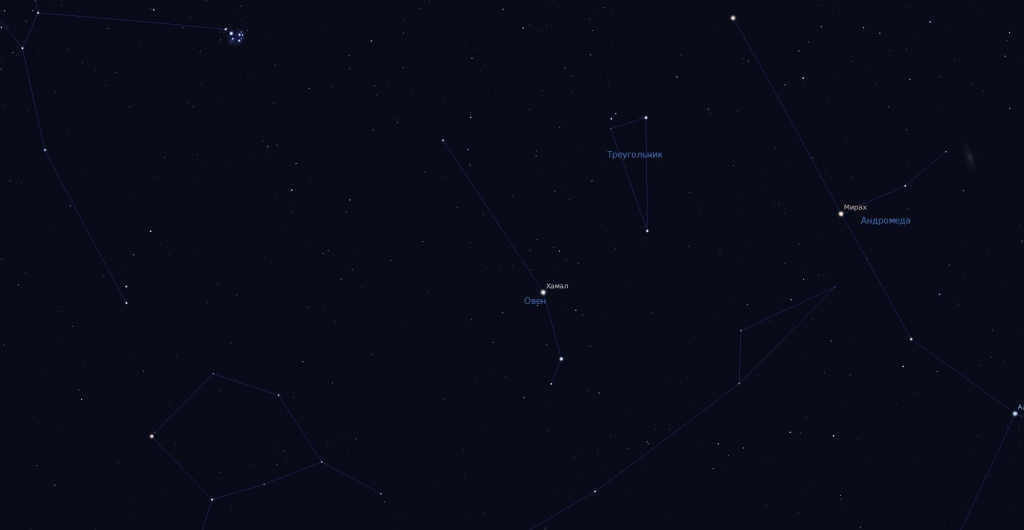
The optimal time to observe the Aries constellation is during the autumn season, when it can be seen in the southern part of the horizon. This celestial display can be enjoyed throughout Russia, particularly on the lengthy nights of November. As for the positioning of the Sun within this constellation, it is commonly believed that the Sun resides in Aries from April 19 to May 13.
The constellation of Aries covers a region of 441.1 square degrees in the celestial sphere. There are three notable stars in this constellation that we will discuss, beginning with the brightest one known as Hamal.
Hamal
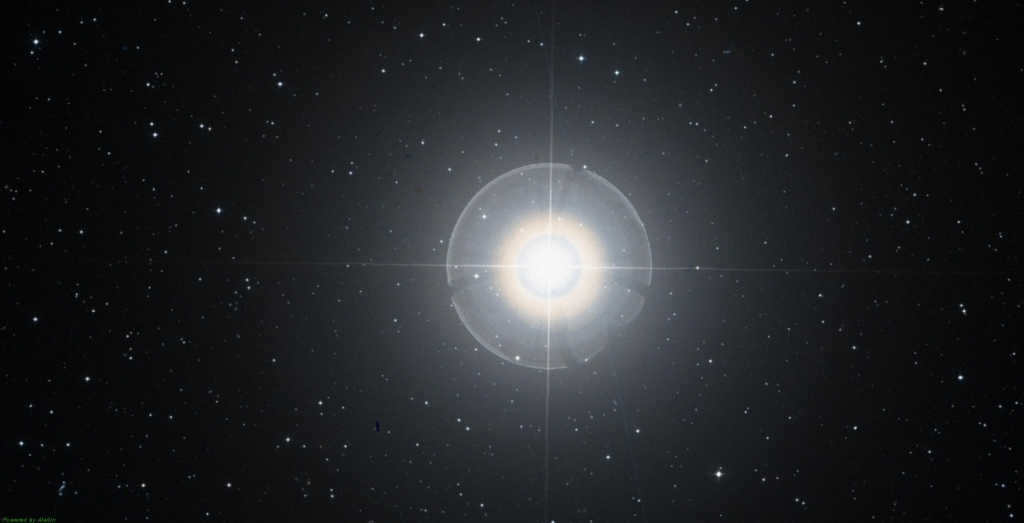
Sheratan is another name for the star Alpha Aries.
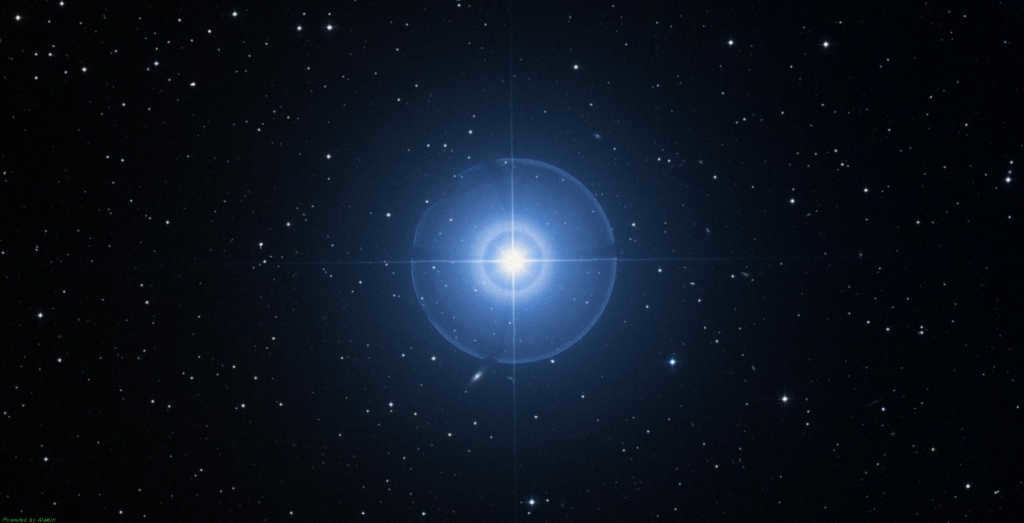
The Mezarthim
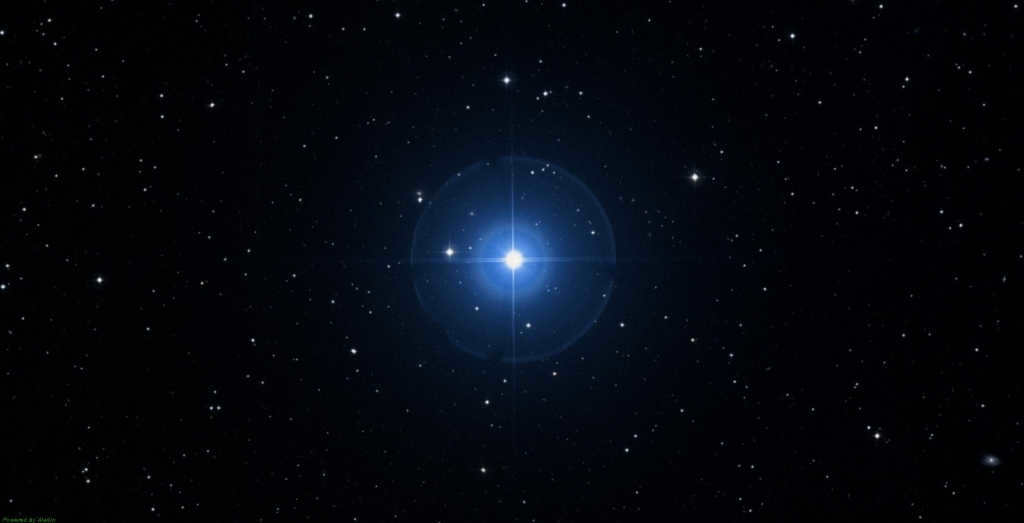
The third brightest star in the constellation being discussed is commonly known as Mezarthim, also referred to as the gamma of Aries. Mezarthim is notable for being one of the first stars to have its duality discovered through the use of a telescope in the year 1664. This discovery was made by Robert Hooke. In terms of its apparent stellar magnitude, scientists classify Mezarthim as having a value of 3.88m. This triple star has a spectral class of B9 V and is located approximately 204 light-years away from Earth.
Did you know these interesting facts about the constellation?
Interestingly, during the early modern era, the position of the zodiac signs in the sky aligned with corresponding zodiacal constellations. At that time, the vernal equinox point was situated within this specific constellation. From an astronomical perspective, this point represents the intersection of the equator and the ecliptic. For the average person, this means that when the Sun reaches this point, the duration of daylight equals the length of the night. However, in present times, the vernal equinox point has shifted from Aries to the neighboring constellation Pisces over the course of the past 2000 years. Nevertheless, the symbol of the constellation (distinctive horns) continues to represent both the constellation itself and the equinox point.
Change in the Orientation of the Earth’s Axis
The orientation of the Earth’s axis has undergone a significant shift. Previously, the point of the autumnal equinox was positioned in a different constellation, but now it can be found in Virgo. Similarly, the point of the winter solstice has moved to Sagittarius, and the summer solstice can now be located in Taurus. This change can be attributed to the phenomenon known as precession, which was first discovered by Hipparchus of Rhodes in the second century BC. Precession refers to the gradual shift in the direction of the Earth’s axis caused by the gravitational pull of the moon. This shift occurs in the opposite direction of the Earth’s annual motion around the sun and amounts to approximately 50 angular minutes per year. Consequently, the vernal equinox now takes place slightly earlier each year compared to the previous year.
The Background of the Star Pattern
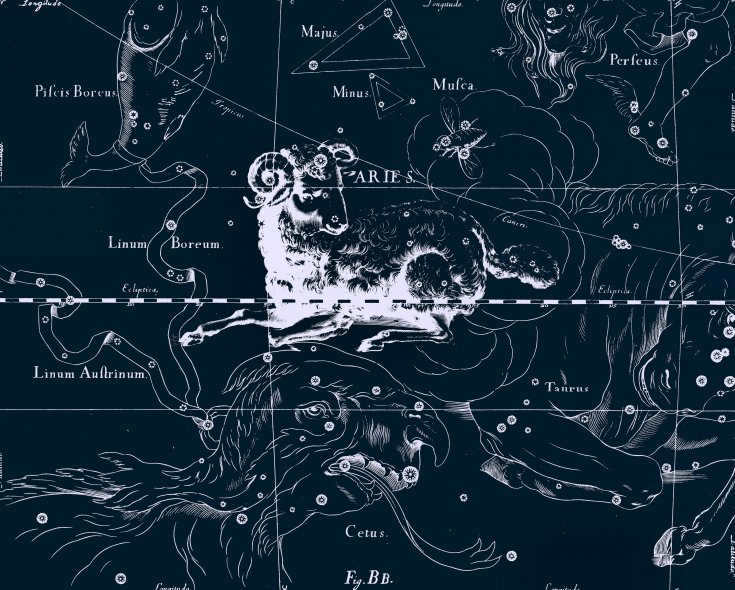
Jan Hevelius’ drawing from his constellation atlas

The constellation Aries can be found in the northern celestial hemisphere. It is part of the well-known zodiacal circle, as it lies in the path of the Sun. Aries, as you may already know, is adjacent to the constellations of Pisces and Taurus. Additionally, there are some star clusters that are not part of the zodiacal circle that are also close by.
Aries is the first constellation in the zodiac. Its name, which means “ram” in English, comes from the ancient Greek astronomers who observed it. They believed that the constellation resembled the horns of a ram.


Aries is the opening constellation in the zodiac
In addition to its involvement in the zodiac, Aries is well-known due to the myth of the Golden Fleece originating from ancient Greece. Aries, depicted as a winged ram with golden hair, was sent by the goddess Nephela to rescue her children. The ram successfully completed its mission, but was later sacrificed to other gods. The Golden Fleece, which is the ram’s skin, was left in the gods’ temple, while the ram itself was immortalized in the sky as a constellation.

Stars found in the Aries constellation
The primary and most luminous star in Aries is known as Alpha, which is a colossal orange star referred to as Hamal. The selection of this name was not arbitrary, as it signifies the head of a ram.
Furthermore, there are an additional five stars present within the Aries constellation, although their brightness is not comparable to these three stars, causing them to be frequently overlooked.

Galaxies in Aries Constellation
The Aries constellation contains a total of 441 square degrees and is ranked as the 39th largest among all constellations. Within this constellation, three spiral galaxies can be observed, with one galaxy even hosting two simultaneous supernovae. Additionally, the irregular dwarf galaxy NGC 1156 can be found in this area. It is worth noting that NGC 1156 does not have a clearly defined shape.






